The Role of Business Strategy on Climate Change and Climate Management Incentives in Carbon Emissions Reduction
VerifiedAdded on 2023/06/07
|23
|3575
|182
AI Summary
This research paper interrogates the role that business strategies on climate change and climate management incentives have in carbon emission reduction for the case of five western countries. The dataset considered for the analysis in this research paper consists of a sample size = 699 firms. The sample of firms was drawn from five countries among the western economies. The choice of the countries is not only meant to include countries from the western economies. These countries represent the different socio-economic systems that are present in the western world.
Contribute Materials
Your contribution can guide someone’s learning journey. Share your
documents today.
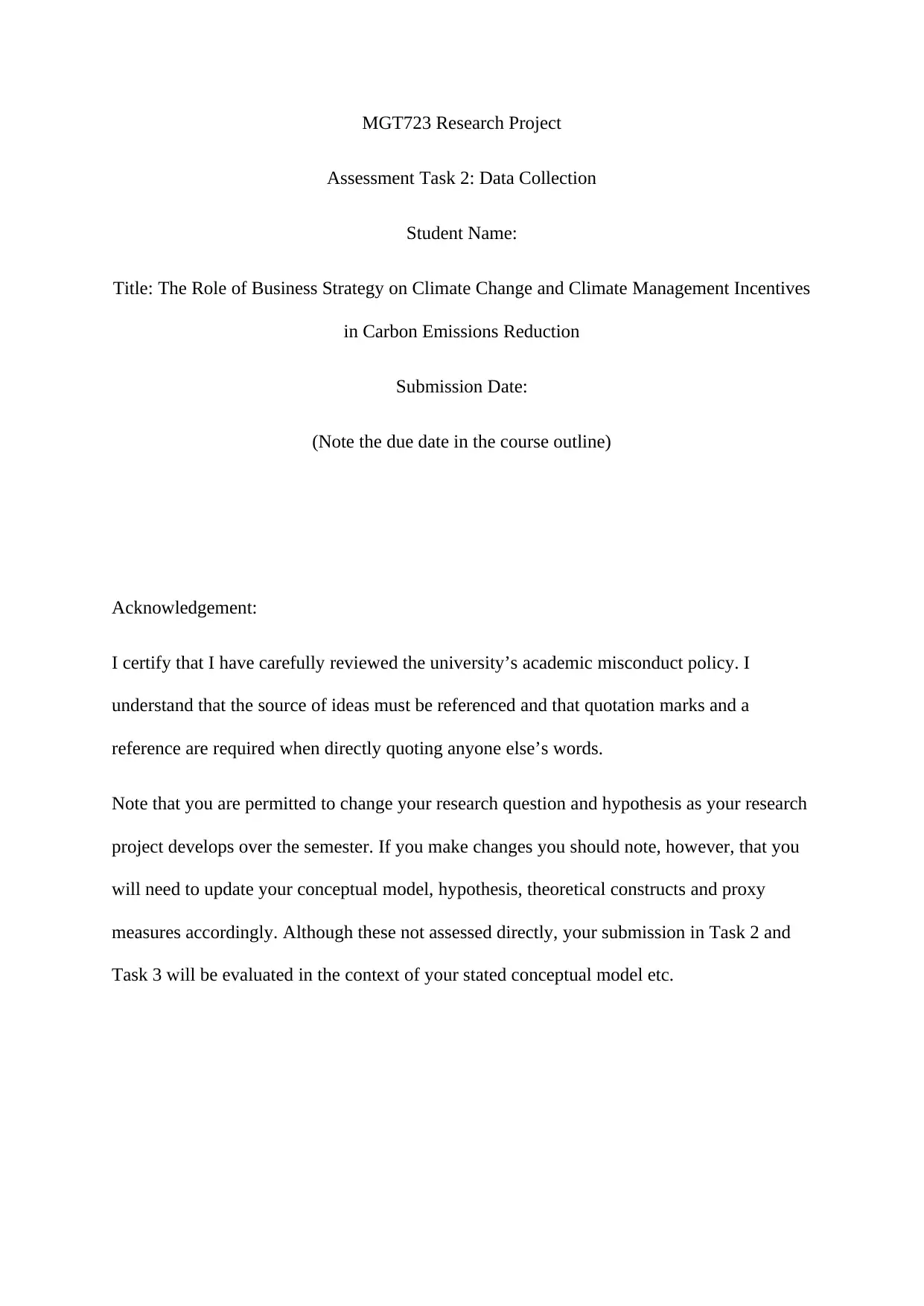
MGT723 Research Project
Assessment Task 2: Data Collection
Student Name:
Title: The Role of Business Strategy on Climate Change and Climate Management Incentives
in Carbon Emissions Reduction
Submission Date:
(Note the due date in the course outline)
Acknowledgement:
I certify that I have carefully reviewed the university’s academic misconduct policy. I
understand that the source of ideas must be referenced and that quotation marks and a
reference are required when directly quoting anyone else’s words.
Note that you are permitted to change your research question and hypothesis as your research
project develops over the semester. If you make changes you should note, however, that you
will need to update your conceptual model, hypothesis, theoretical constructs and proxy
measures accordingly. Although these not assessed directly, your submission in Task 2 and
Task 3 will be evaluated in the context of your stated conceptual model etc.
Assessment Task 2: Data Collection
Student Name:
Title: The Role of Business Strategy on Climate Change and Climate Management Incentives
in Carbon Emissions Reduction
Submission Date:
(Note the due date in the course outline)
Acknowledgement:
I certify that I have carefully reviewed the university’s academic misconduct policy. I
understand that the source of ideas must be referenced and that quotation marks and a
reference are required when directly quoting anyone else’s words.
Note that you are permitted to change your research question and hypothesis as your research
project develops over the semester. If you make changes you should note, however, that you
will need to update your conceptual model, hypothesis, theoretical constructs and proxy
measures accordingly. Although these not assessed directly, your submission in Task 2 and
Task 3 will be evaluated in the context of your stated conceptual model etc.
Secure Best Marks with AI Grader
Need help grading? Try our AI Grader for instant feedback on your assignments.
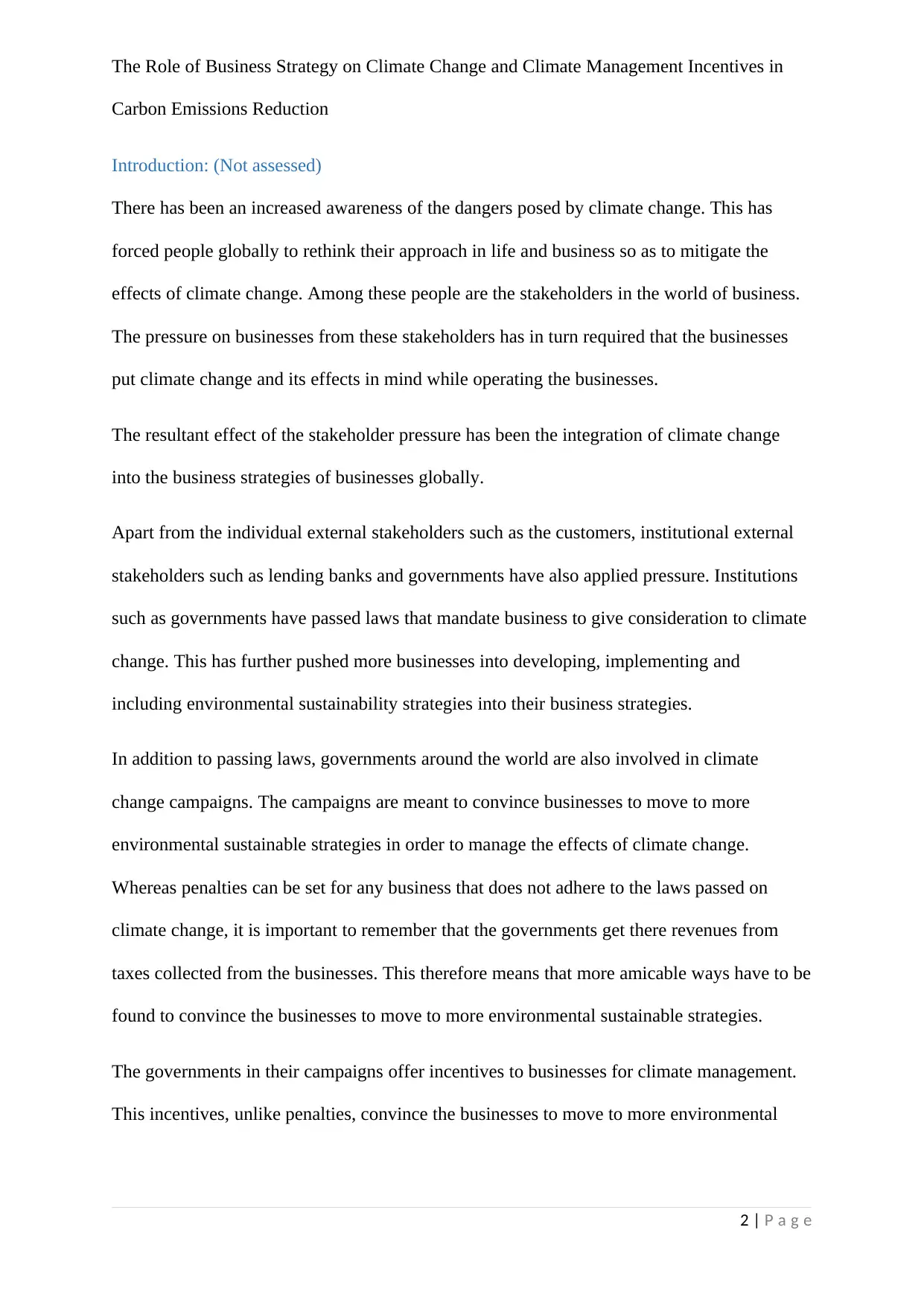
The Role of Business Strategy on Climate Change and Climate Management Incentives in
Carbon Emissions Reduction
Introduction: (Not assessed)
There has been an increased awareness of the dangers posed by climate change. This has
forced people globally to rethink their approach in life and business so as to mitigate the
effects of climate change. Among these people are the stakeholders in the world of business.
The pressure on businesses from these stakeholders has in turn required that the businesses
put climate change and its effects in mind while operating the businesses.
The resultant effect of the stakeholder pressure has been the integration of climate change
into the business strategies of businesses globally.
Apart from the individual external stakeholders such as the customers, institutional external
stakeholders such as lending banks and governments have also applied pressure. Institutions
such as governments have passed laws that mandate business to give consideration to climate
change. This has further pushed more businesses into developing, implementing and
including environmental sustainability strategies into their business strategies.
In addition to passing laws, governments around the world are also involved in climate
change campaigns. The campaigns are meant to convince businesses to move to more
environmental sustainable strategies in order to manage the effects of climate change.
Whereas penalties can be set for any business that does not adhere to the laws passed on
climate change, it is important to remember that the governments get there revenues from
taxes collected from the businesses. This therefore means that more amicable ways have to be
found to convince the businesses to move to more environmental sustainable strategies.
The governments in their campaigns offer incentives to businesses for climate management.
This incentives, unlike penalties, convince the businesses to move to more environmental
2 | P a g e
Carbon Emissions Reduction
Introduction: (Not assessed)
There has been an increased awareness of the dangers posed by climate change. This has
forced people globally to rethink their approach in life and business so as to mitigate the
effects of climate change. Among these people are the stakeholders in the world of business.
The pressure on businesses from these stakeholders has in turn required that the businesses
put climate change and its effects in mind while operating the businesses.
The resultant effect of the stakeholder pressure has been the integration of climate change
into the business strategies of businesses globally.
Apart from the individual external stakeholders such as the customers, institutional external
stakeholders such as lending banks and governments have also applied pressure. Institutions
such as governments have passed laws that mandate business to give consideration to climate
change. This has further pushed more businesses into developing, implementing and
including environmental sustainability strategies into their business strategies.
In addition to passing laws, governments around the world are also involved in climate
change campaigns. The campaigns are meant to convince businesses to move to more
environmental sustainable strategies in order to manage the effects of climate change.
Whereas penalties can be set for any business that does not adhere to the laws passed on
climate change, it is important to remember that the governments get there revenues from
taxes collected from the businesses. This therefore means that more amicable ways have to be
found to convince the businesses to move to more environmental sustainable strategies.
The governments in their campaigns offer incentives to businesses for climate management.
This incentives, unlike penalties, convince the businesses to move to more environmental
2 | P a g e
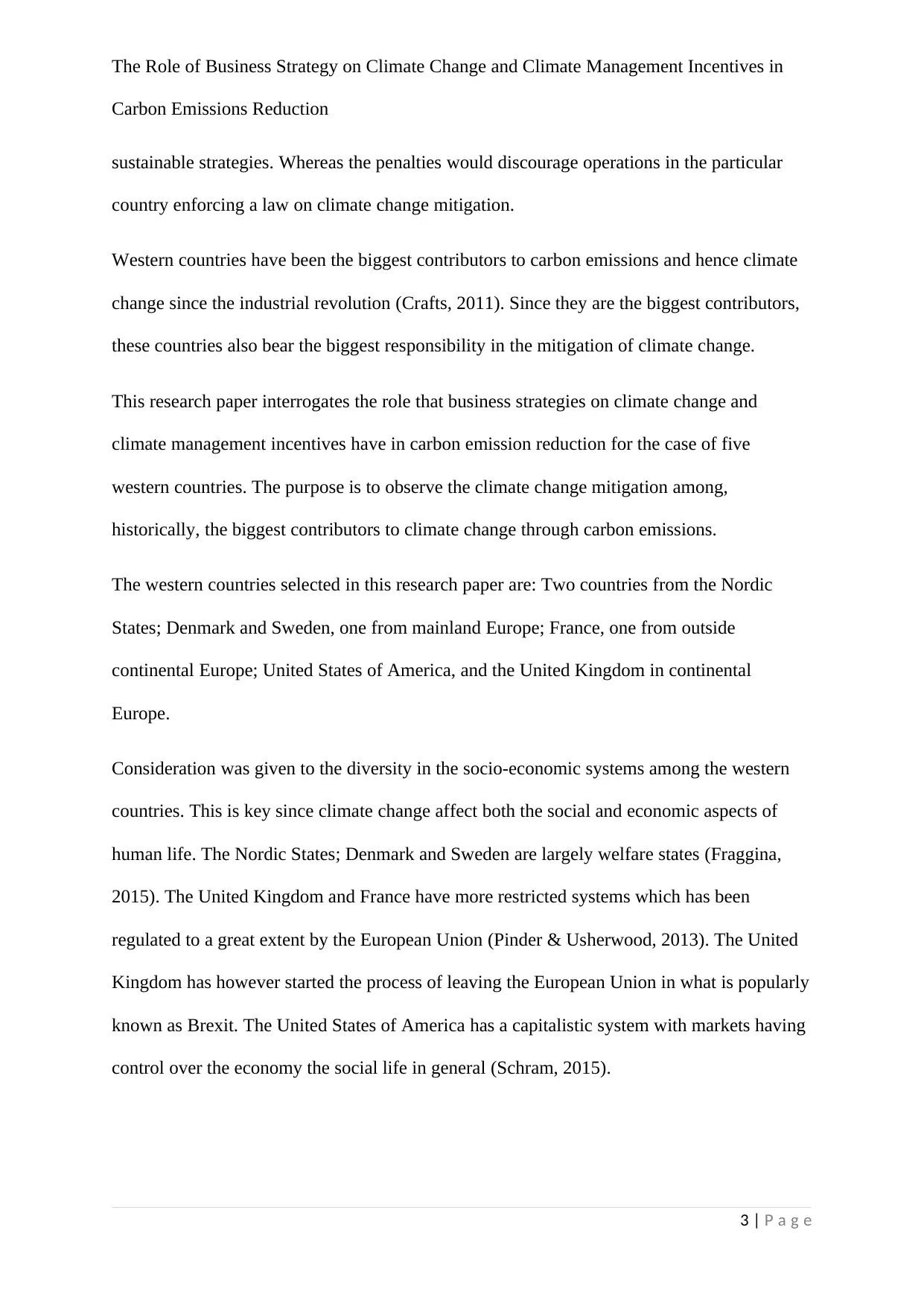
The Role of Business Strategy on Climate Change and Climate Management Incentives in
Carbon Emissions Reduction
sustainable strategies. Whereas the penalties would discourage operations in the particular
country enforcing a law on climate change mitigation.
Western countries have been the biggest contributors to carbon emissions and hence climate
change since the industrial revolution (Crafts, 2011). Since they are the biggest contributors,
these countries also bear the biggest responsibility in the mitigation of climate change.
This research paper interrogates the role that business strategies on climate change and
climate management incentives have in carbon emission reduction for the case of five
western countries. The purpose is to observe the climate change mitigation among,
historically, the biggest contributors to climate change through carbon emissions.
The western countries selected in this research paper are: Two countries from the Nordic
States; Denmark and Sweden, one from mainland Europe; France, one from outside
continental Europe; United States of America, and the United Kingdom in continental
Europe.
Consideration was given to the diversity in the socio-economic systems among the western
countries. This is key since climate change affect both the social and economic aspects of
human life. The Nordic States; Denmark and Sweden are largely welfare states (Fraggina,
2015). The United Kingdom and France have more restricted systems which has been
regulated to a great extent by the European Union (Pinder & Usherwood, 2013). The United
Kingdom has however started the process of leaving the European Union in what is popularly
known as Brexit. The United States of America has a capitalistic system with markets having
control over the economy the social life in general (Schram, 2015).
3 | P a g e
Carbon Emissions Reduction
sustainable strategies. Whereas the penalties would discourage operations in the particular
country enforcing a law on climate change mitigation.
Western countries have been the biggest contributors to carbon emissions and hence climate
change since the industrial revolution (Crafts, 2011). Since they are the biggest contributors,
these countries also bear the biggest responsibility in the mitigation of climate change.
This research paper interrogates the role that business strategies on climate change and
climate management incentives have in carbon emission reduction for the case of five
western countries. The purpose is to observe the climate change mitigation among,
historically, the biggest contributors to climate change through carbon emissions.
The western countries selected in this research paper are: Two countries from the Nordic
States; Denmark and Sweden, one from mainland Europe; France, one from outside
continental Europe; United States of America, and the United Kingdom in continental
Europe.
Consideration was given to the diversity in the socio-economic systems among the western
countries. This is key since climate change affect both the social and economic aspects of
human life. The Nordic States; Denmark and Sweden are largely welfare states (Fraggina,
2015). The United Kingdom and France have more restricted systems which has been
regulated to a great extent by the European Union (Pinder & Usherwood, 2013). The United
Kingdom has however started the process of leaving the European Union in what is popularly
known as Brexit. The United States of America has a capitalistic system with markets having
control over the economy the social life in general (Schram, 2015).
3 | P a g e
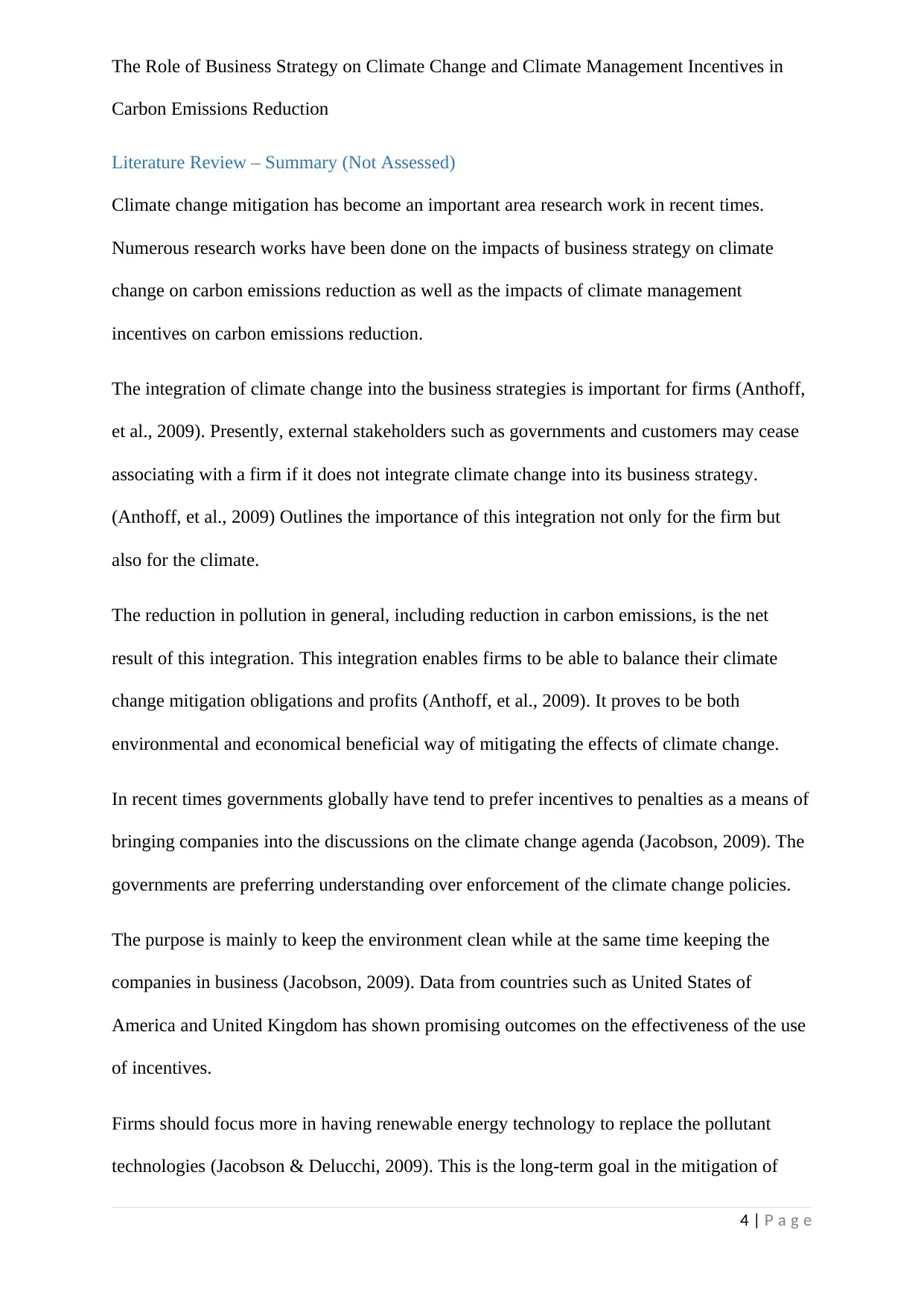
The Role of Business Strategy on Climate Change and Climate Management Incentives in
Carbon Emissions Reduction
Literature Review – Summary (Not Assessed)
Climate change mitigation has become an important area research work in recent times.
Numerous research works have been done on the impacts of business strategy on climate
change on carbon emissions reduction as well as the impacts of climate management
incentives on carbon emissions reduction.
The integration of climate change into the business strategies is important for firms (Anthoff,
et al., 2009). Presently, external stakeholders such as governments and customers may cease
associating with a firm if it does not integrate climate change into its business strategy.
(Anthoff, et al., 2009) Outlines the importance of this integration not only for the firm but
also for the climate.
The reduction in pollution in general, including reduction in carbon emissions, is the net
result of this integration. This integration enables firms to be able to balance their climate
change mitigation obligations and profits (Anthoff, et al., 2009). It proves to be both
environmental and economical beneficial way of mitigating the effects of climate change.
In recent times governments globally have tend to prefer incentives to penalties as a means of
bringing companies into the discussions on the climate change agenda (Jacobson, 2009). The
governments are preferring understanding over enforcement of the climate change policies.
The purpose is mainly to keep the environment clean while at the same time keeping the
companies in business (Jacobson, 2009). Data from countries such as United States of
America and United Kingdom has shown promising outcomes on the effectiveness of the use
of incentives.
Firms should focus more in having renewable energy technology to replace the pollutant
technologies (Jacobson & Delucchi, 2009). This is the long-term goal in the mitigation of
4 | P a g e
Carbon Emissions Reduction
Literature Review – Summary (Not Assessed)
Climate change mitigation has become an important area research work in recent times.
Numerous research works have been done on the impacts of business strategy on climate
change on carbon emissions reduction as well as the impacts of climate management
incentives on carbon emissions reduction.
The integration of climate change into the business strategies is important for firms (Anthoff,
et al., 2009). Presently, external stakeholders such as governments and customers may cease
associating with a firm if it does not integrate climate change into its business strategy.
(Anthoff, et al., 2009) Outlines the importance of this integration not only for the firm but
also for the climate.
The reduction in pollution in general, including reduction in carbon emissions, is the net
result of this integration. This integration enables firms to be able to balance their climate
change mitigation obligations and profits (Anthoff, et al., 2009). It proves to be both
environmental and economical beneficial way of mitigating the effects of climate change.
In recent times governments globally have tend to prefer incentives to penalties as a means of
bringing companies into the discussions on the climate change agenda (Jacobson, 2009). The
governments are preferring understanding over enforcement of the climate change policies.
The purpose is mainly to keep the environment clean while at the same time keeping the
companies in business (Jacobson, 2009). Data from countries such as United States of
America and United Kingdom has shown promising outcomes on the effectiveness of the use
of incentives.
Firms should focus more in having renewable energy technology to replace the pollutant
technologies (Jacobson & Delucchi, 2009). This is the long-term goal in the mitigation of
4 | P a g e
Secure Best Marks with AI Grader
Need help grading? Try our AI Grader for instant feedback on your assignments.
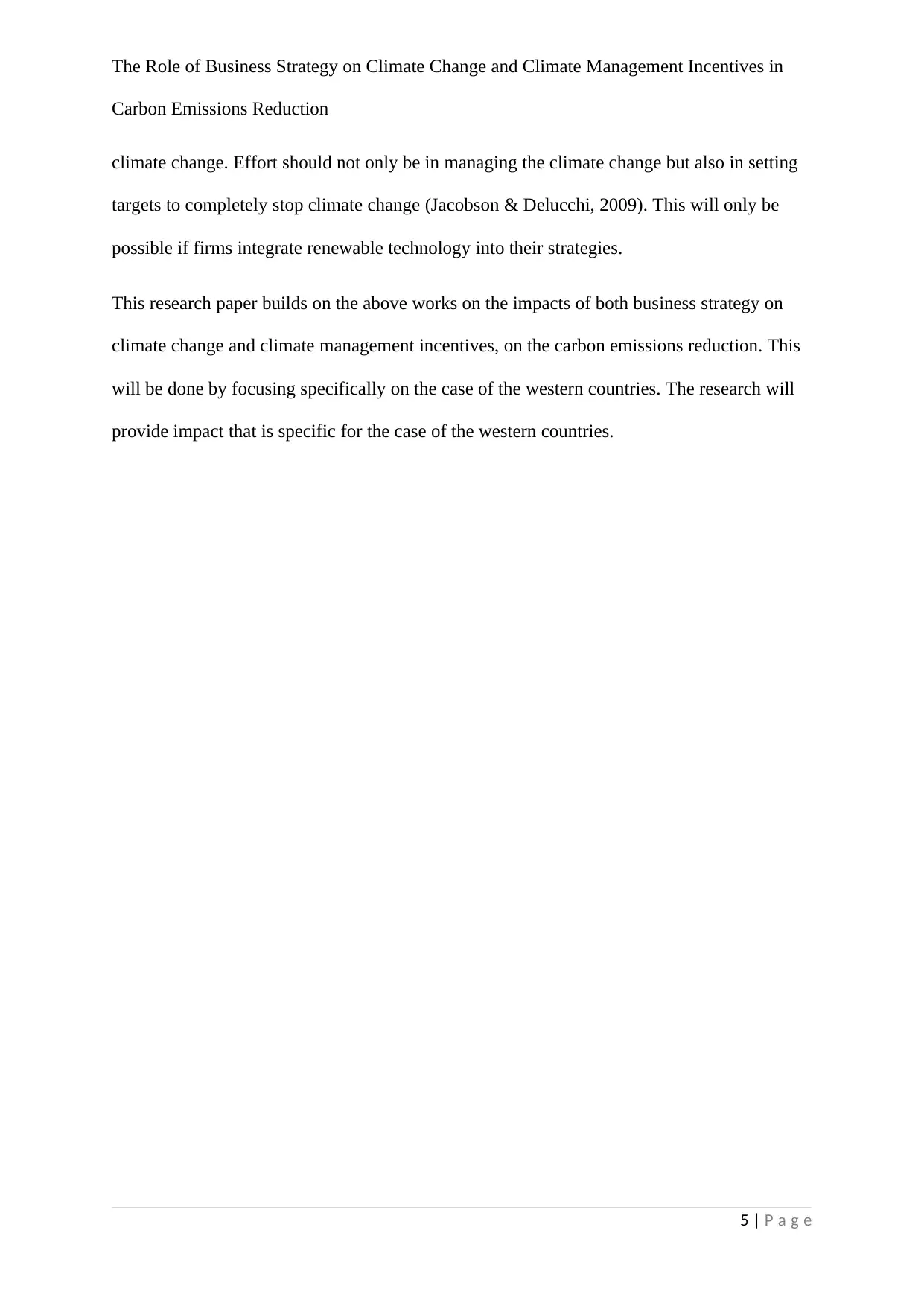
The Role of Business Strategy on Climate Change and Climate Management Incentives in
Carbon Emissions Reduction
climate change. Effort should not only be in managing the climate change but also in setting
targets to completely stop climate change (Jacobson & Delucchi, 2009). This will only be
possible if firms integrate renewable technology into their strategies.
This research paper builds on the above works on the impacts of both business strategy on
climate change and climate management incentives, on the carbon emissions reduction. This
will be done by focusing specifically on the case of the western countries. The research will
provide impact that is specific for the case of the western countries.
5 | P a g e
Carbon Emissions Reduction
climate change. Effort should not only be in managing the climate change but also in setting
targets to completely stop climate change (Jacobson & Delucchi, 2009). This will only be
possible if firms integrate renewable technology into their strategies.
This research paper builds on the above works on the impacts of both business strategy on
climate change and climate management incentives, on the carbon emissions reduction. This
will be done by focusing specifically on the case of the western countries. The research will
provide impact that is specific for the case of the western countries.
5 | P a g e
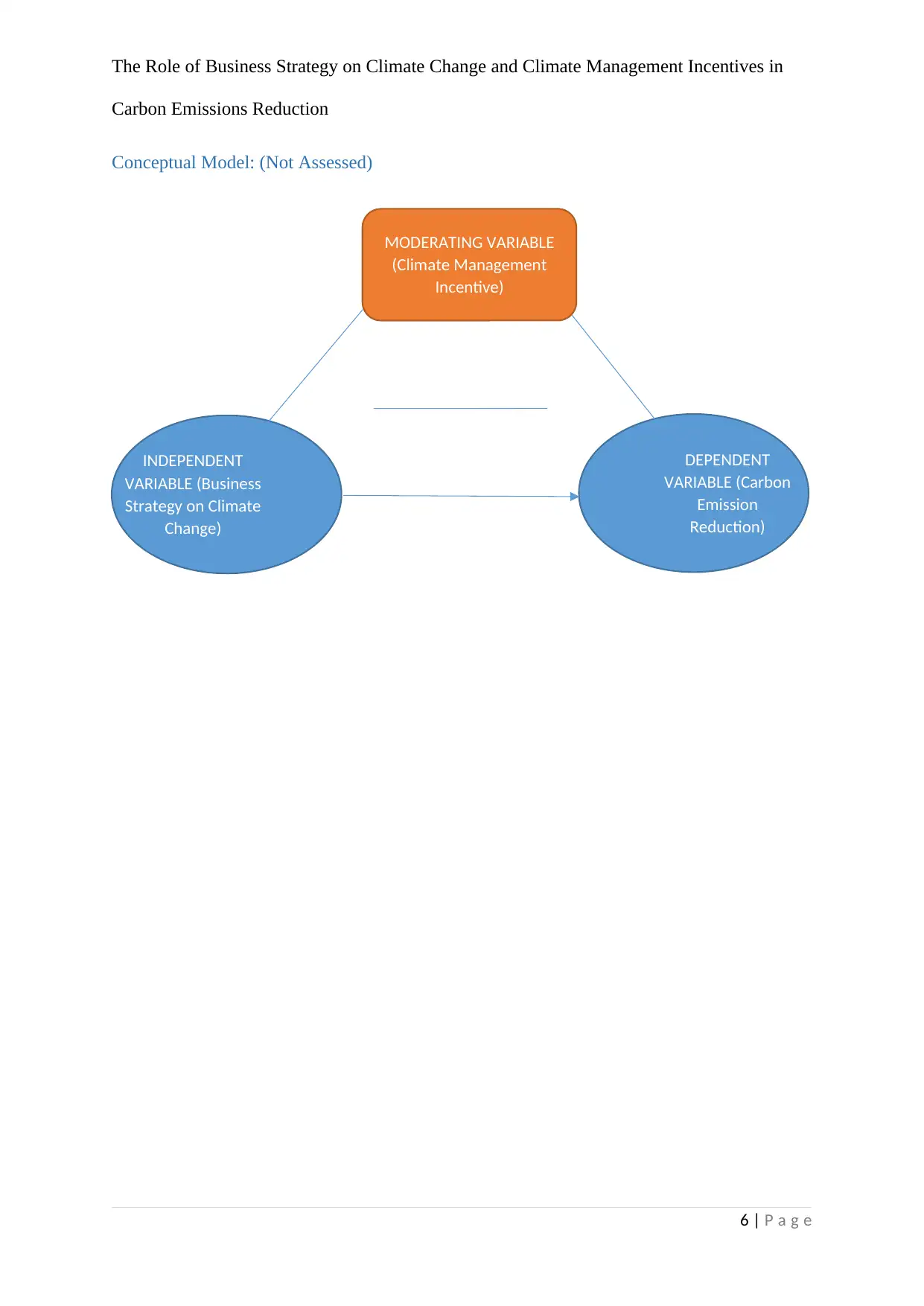
The Role of Business Strategy on Climate Change and Climate Management Incentives in
Carbon Emissions Reduction
Conceptual Model: (Not Assessed)
6 | P a g e
MODERATING VARIABLE
(Climate Management
Incentive)
INDEPENDENT
VARIABLE (Business
Strategy on Climate
Change)
DEPENDENT
VARIABLE (Carbon
Emission
Reduction)
Carbon Emissions Reduction
Conceptual Model: (Not Assessed)
6 | P a g e
MODERATING VARIABLE
(Climate Management
Incentive)
INDEPENDENT
VARIABLE (Business
Strategy on Climate
Change)
DEPENDENT
VARIABLE (Carbon
Emission
Reduction)
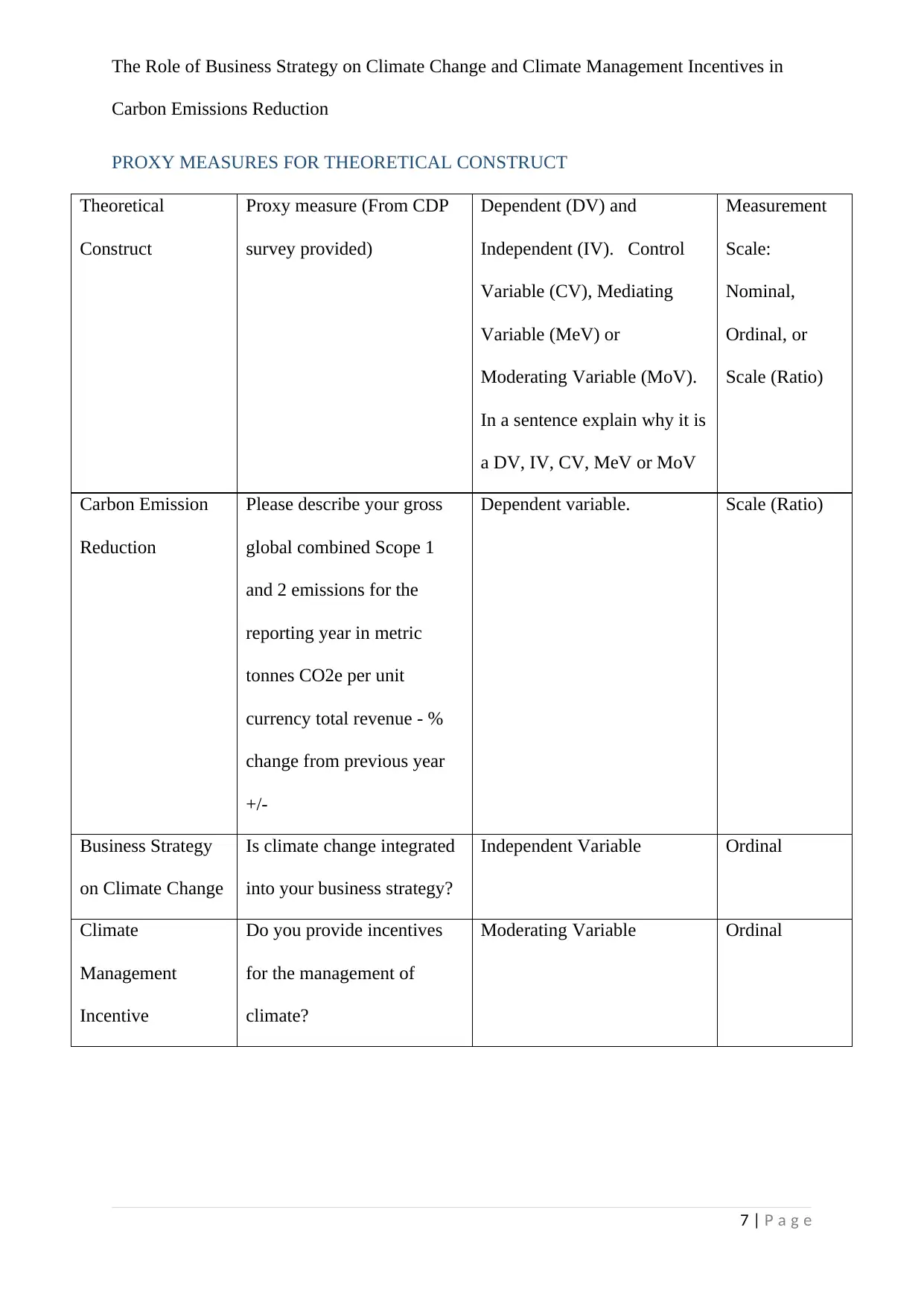
The Role of Business Strategy on Climate Change and Climate Management Incentives in
Carbon Emissions Reduction
PROXY MEASURES FOR THEORETICAL CONSTRUCT
Theoretical
Construct
Proxy measure (From CDP
survey provided)
Dependent (DV) and
Independent (IV). Control
Variable (CV), Mediating
Variable (MeV) or
Moderating Variable (MoV).
In a sentence explain why it is
a DV, IV, CV, MeV or MoV
Measurement
Scale:
Nominal,
Ordinal, or
Scale (Ratio)
Carbon Emission
Reduction
Please describe your gross
global combined Scope 1
and 2 emissions for the
reporting year in metric
tonnes CO2e per unit
currency total revenue - %
change from previous year
+/-
Dependent variable. Scale (Ratio)
Business Strategy
on Climate Change
Is climate change integrated
into your business strategy?
Independent Variable Ordinal
Climate
Management
Incentive
Do you provide incentives
for the management of
climate?
Moderating Variable Ordinal
7 | P a g e
Carbon Emissions Reduction
PROXY MEASURES FOR THEORETICAL CONSTRUCT
Theoretical
Construct
Proxy measure (From CDP
survey provided)
Dependent (DV) and
Independent (IV). Control
Variable (CV), Mediating
Variable (MeV) or
Moderating Variable (MoV).
In a sentence explain why it is
a DV, IV, CV, MeV or MoV
Measurement
Scale:
Nominal,
Ordinal, or
Scale (Ratio)
Carbon Emission
Reduction
Please describe your gross
global combined Scope 1
and 2 emissions for the
reporting year in metric
tonnes CO2e per unit
currency total revenue - %
change from previous year
+/-
Dependent variable. Scale (Ratio)
Business Strategy
on Climate Change
Is climate change integrated
into your business strategy?
Independent Variable Ordinal
Climate
Management
Incentive
Do you provide incentives
for the management of
climate?
Moderating Variable Ordinal
7 | P a g e
Paraphrase This Document
Need a fresh take? Get an instant paraphrase of this document with our AI Paraphraser
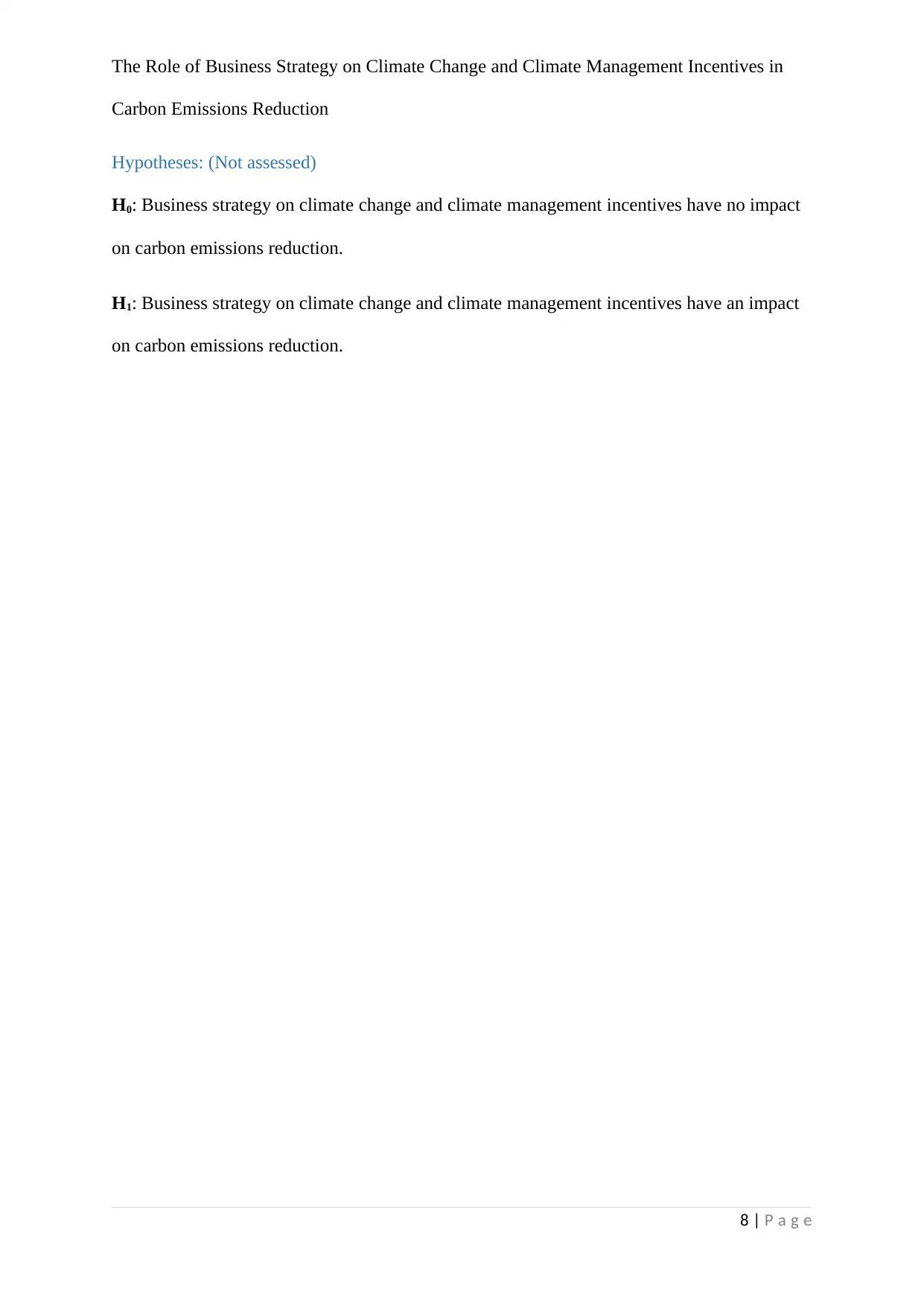
The Role of Business Strategy on Climate Change and Climate Management Incentives in
Carbon Emissions Reduction
Hypotheses: (Not assessed)
H0: Business strategy on climate change and climate management incentives have no impact
on carbon emissions reduction.
H1: Business strategy on climate change and climate management incentives have an impact
on carbon emissions reduction.
8 | P a g e
Carbon Emissions Reduction
Hypotheses: (Not assessed)
H0: Business strategy on climate change and climate management incentives have no impact
on carbon emissions reduction.
H1: Business strategy on climate change and climate management incentives have an impact
on carbon emissions reduction.
8 | P a g e
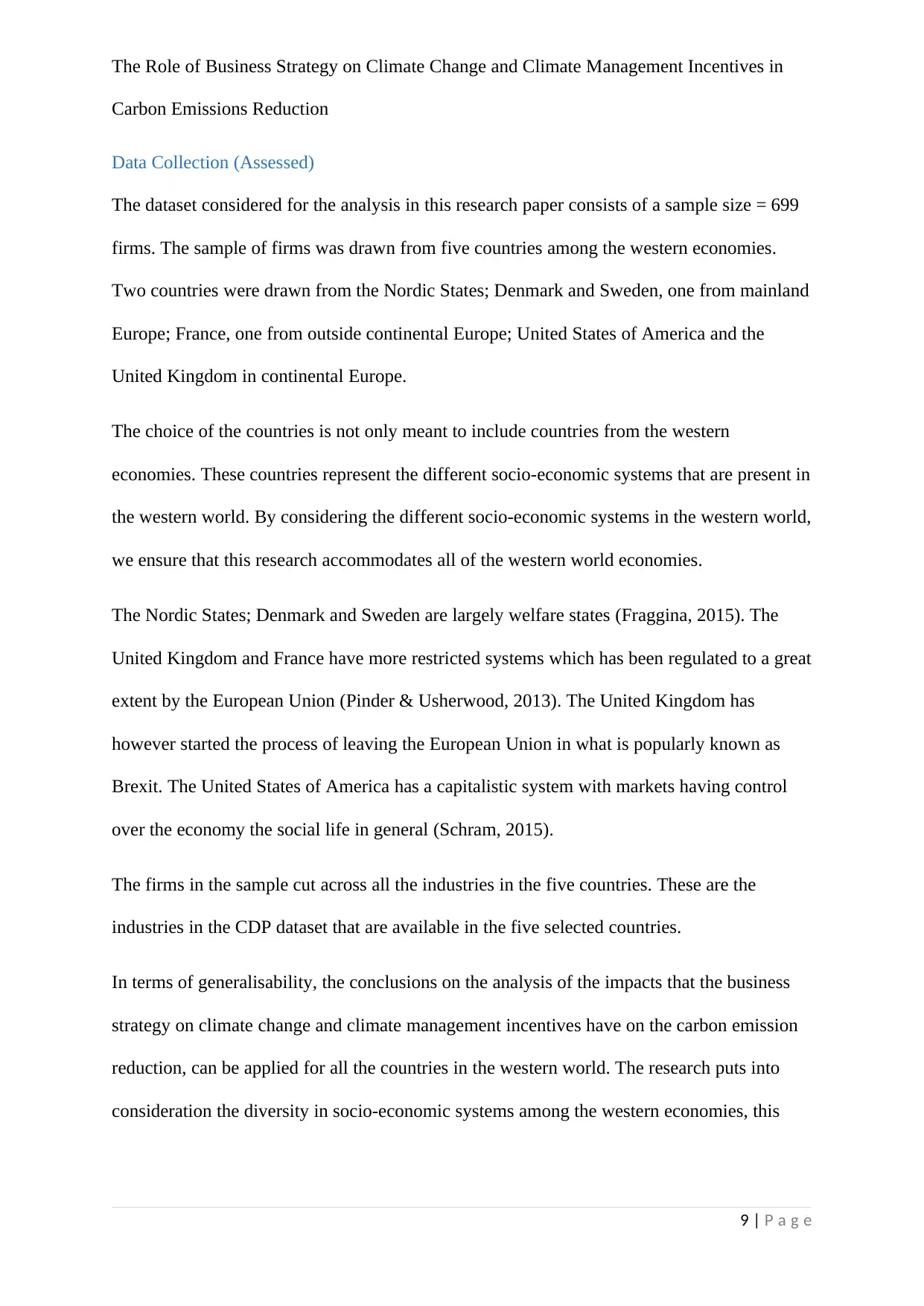
The Role of Business Strategy on Climate Change and Climate Management Incentives in
Carbon Emissions Reduction
Data Collection (Assessed)
The dataset considered for the analysis in this research paper consists of a sample size = 699
firms. The sample of firms was drawn from five countries among the western economies.
Two countries were drawn from the Nordic States; Denmark and Sweden, one from mainland
Europe; France, one from outside continental Europe; United States of America and the
United Kingdom in continental Europe.
The choice of the countries is not only meant to include countries from the western
economies. These countries represent the different socio-economic systems that are present in
the western world. By considering the different socio-economic systems in the western world,
we ensure that this research accommodates all of the western world economies.
The Nordic States; Denmark and Sweden are largely welfare states (Fraggina, 2015). The
United Kingdom and France have more restricted systems which has been regulated to a great
extent by the European Union (Pinder & Usherwood, 2013). The United Kingdom has
however started the process of leaving the European Union in what is popularly known as
Brexit. The United States of America has a capitalistic system with markets having control
over the economy the social life in general (Schram, 2015).
The firms in the sample cut across all the industries in the five countries. These are the
industries in the CDP dataset that are available in the five selected countries.
In terms of generalisability, the conclusions on the analysis of the impacts that the business
strategy on climate change and climate management incentives have on the carbon emission
reduction, can be applied for all the countries in the western world. The research puts into
consideration the diversity in socio-economic systems among the western economies, this
9 | P a g e
Carbon Emissions Reduction
Data Collection (Assessed)
The dataset considered for the analysis in this research paper consists of a sample size = 699
firms. The sample of firms was drawn from five countries among the western economies.
Two countries were drawn from the Nordic States; Denmark and Sweden, one from mainland
Europe; France, one from outside continental Europe; United States of America and the
United Kingdom in continental Europe.
The choice of the countries is not only meant to include countries from the western
economies. These countries represent the different socio-economic systems that are present in
the western world. By considering the different socio-economic systems in the western world,
we ensure that this research accommodates all of the western world economies.
The Nordic States; Denmark and Sweden are largely welfare states (Fraggina, 2015). The
United Kingdom and France have more restricted systems which has been regulated to a great
extent by the European Union (Pinder & Usherwood, 2013). The United Kingdom has
however started the process of leaving the European Union in what is popularly known as
Brexit. The United States of America has a capitalistic system with markets having control
over the economy the social life in general (Schram, 2015).
The firms in the sample cut across all the industries in the five countries. These are the
industries in the CDP dataset that are available in the five selected countries.
In terms of generalisability, the conclusions on the analysis of the impacts that the business
strategy on climate change and climate management incentives have on the carbon emission
reduction, can be applied for all the countries in the western world. The research puts into
consideration the diversity in socio-economic systems among the western economies, this
9 | P a g e
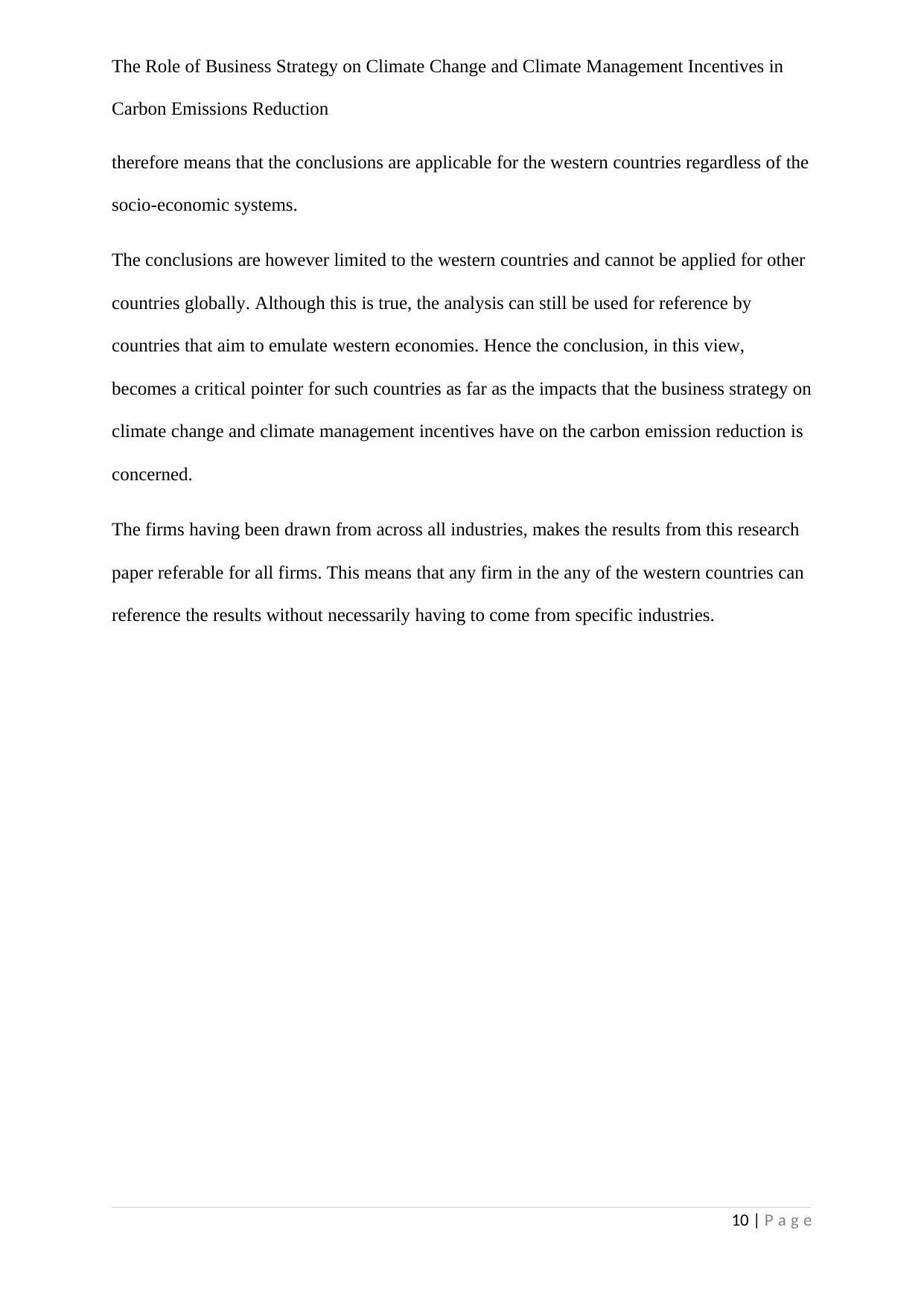
The Role of Business Strategy on Climate Change and Climate Management Incentives in
Carbon Emissions Reduction
therefore means that the conclusions are applicable for the western countries regardless of the
socio-economic systems.
The conclusions are however limited to the western countries and cannot be applied for other
countries globally. Although this is true, the analysis can still be used for reference by
countries that aim to emulate western economies. Hence the conclusion, in this view,
becomes a critical pointer for such countries as far as the impacts that the business strategy on
climate change and climate management incentives have on the carbon emission reduction is
concerned.
The firms having been drawn from across all industries, makes the results from this research
paper referable for all firms. This means that any firm in the any of the western countries can
reference the results without necessarily having to come from specific industries.
10 | P a g e
Carbon Emissions Reduction
therefore means that the conclusions are applicable for the western countries regardless of the
socio-economic systems.
The conclusions are however limited to the western countries and cannot be applied for other
countries globally. Although this is true, the analysis can still be used for reference by
countries that aim to emulate western economies. Hence the conclusion, in this view,
becomes a critical pointer for such countries as far as the impacts that the business strategy on
climate change and climate management incentives have on the carbon emission reduction is
concerned.
The firms having been drawn from across all industries, makes the results from this research
paper referable for all firms. This means that any firm in the any of the western countries can
reference the results without necessarily having to come from specific industries.
10 | P a g e
Secure Best Marks with AI Grader
Need help grading? Try our AI Grader for instant feedback on your assignments.
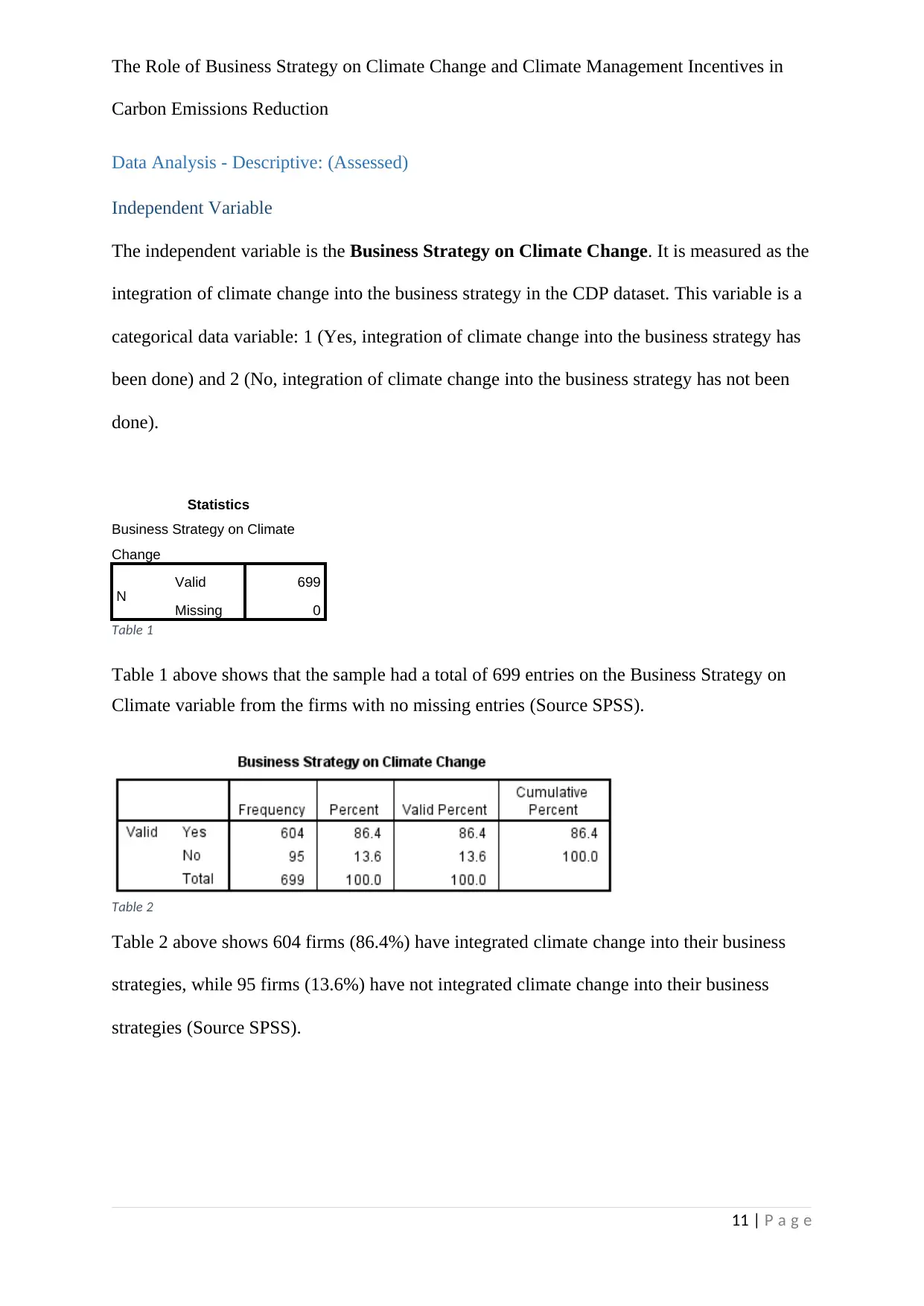
The Role of Business Strategy on Climate Change and Climate Management Incentives in
Carbon Emissions Reduction
Data Analysis - Descriptive: (Assessed)
Independent Variable
The independent variable is the Business Strategy on Climate Change. It is measured as the
integration of climate change into the business strategy in the CDP dataset. This variable is a
categorical data variable: 1 (Yes, integration of climate change into the business strategy has
been done) and 2 (No, integration of climate change into the business strategy has not been
done).
Statistics
Business Strategy on Climate
Change
N Valid 699
Missing 0
Table 1
Table 1 above shows that the sample had a total of 699 entries on the Business Strategy on
Climate variable from the firms with no missing entries (Source SPSS).
Table 2
Table 2 above shows 604 firms (86.4%) have integrated climate change into their business
strategies, while 95 firms (13.6%) have not integrated climate change into their business
strategies (Source SPSS).
11 | P a g e
Carbon Emissions Reduction
Data Analysis - Descriptive: (Assessed)
Independent Variable
The independent variable is the Business Strategy on Climate Change. It is measured as the
integration of climate change into the business strategy in the CDP dataset. This variable is a
categorical data variable: 1 (Yes, integration of climate change into the business strategy has
been done) and 2 (No, integration of climate change into the business strategy has not been
done).
Statistics
Business Strategy on Climate
Change
N Valid 699
Missing 0
Table 1
Table 1 above shows that the sample had a total of 699 entries on the Business Strategy on
Climate variable from the firms with no missing entries (Source SPSS).
Table 2
Table 2 above shows 604 firms (86.4%) have integrated climate change into their business
strategies, while 95 firms (13.6%) have not integrated climate change into their business
strategies (Source SPSS).
11 | P a g e
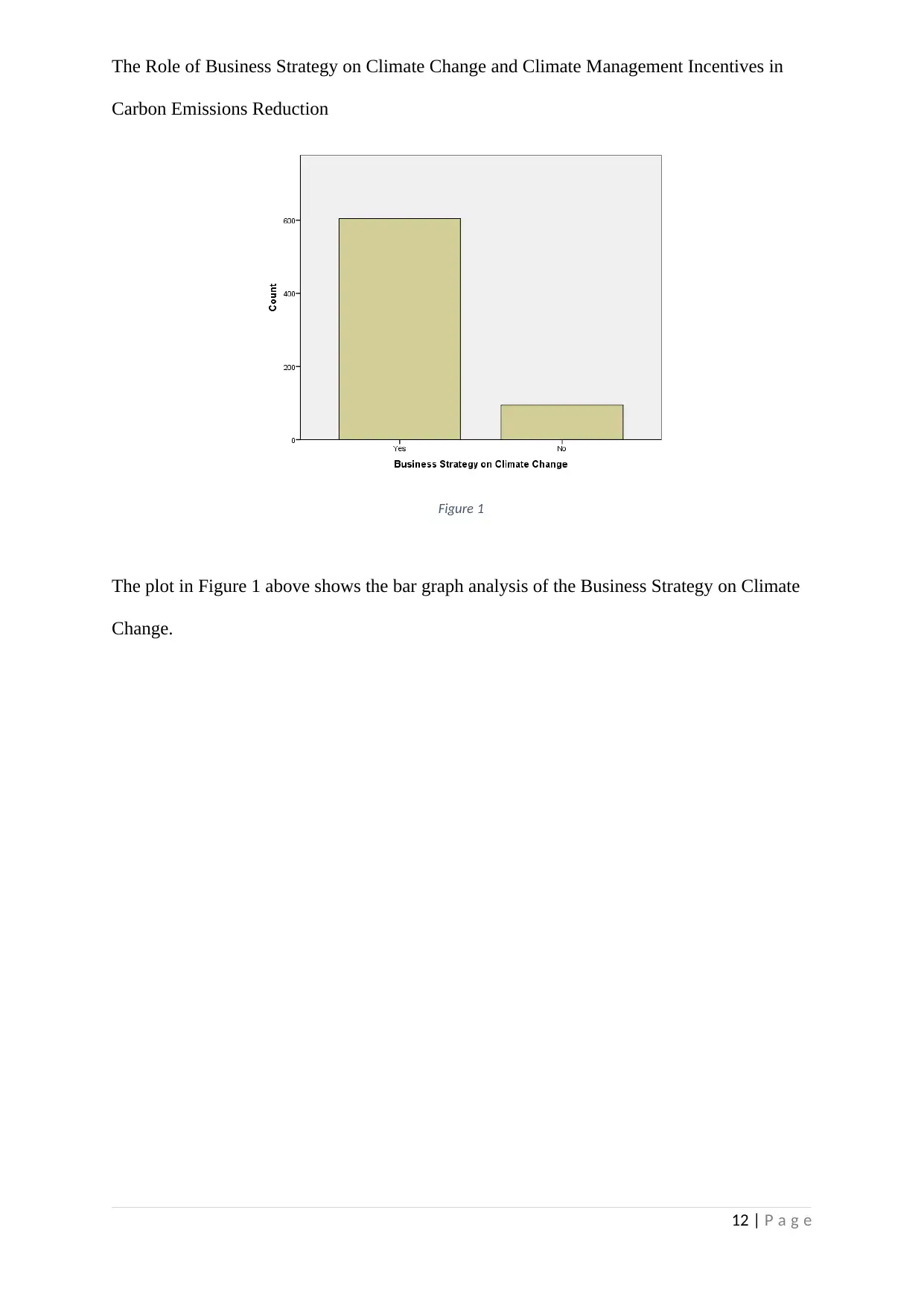
The Role of Business Strategy on Climate Change and Climate Management Incentives in
Carbon Emissions Reduction
Figure 1
The plot in Figure 1 above shows the bar graph analysis of the Business Strategy on Climate
Change.
12 | P a g e
Carbon Emissions Reduction
Figure 1
The plot in Figure 1 above shows the bar graph analysis of the Business Strategy on Climate
Change.
12 | P a g e
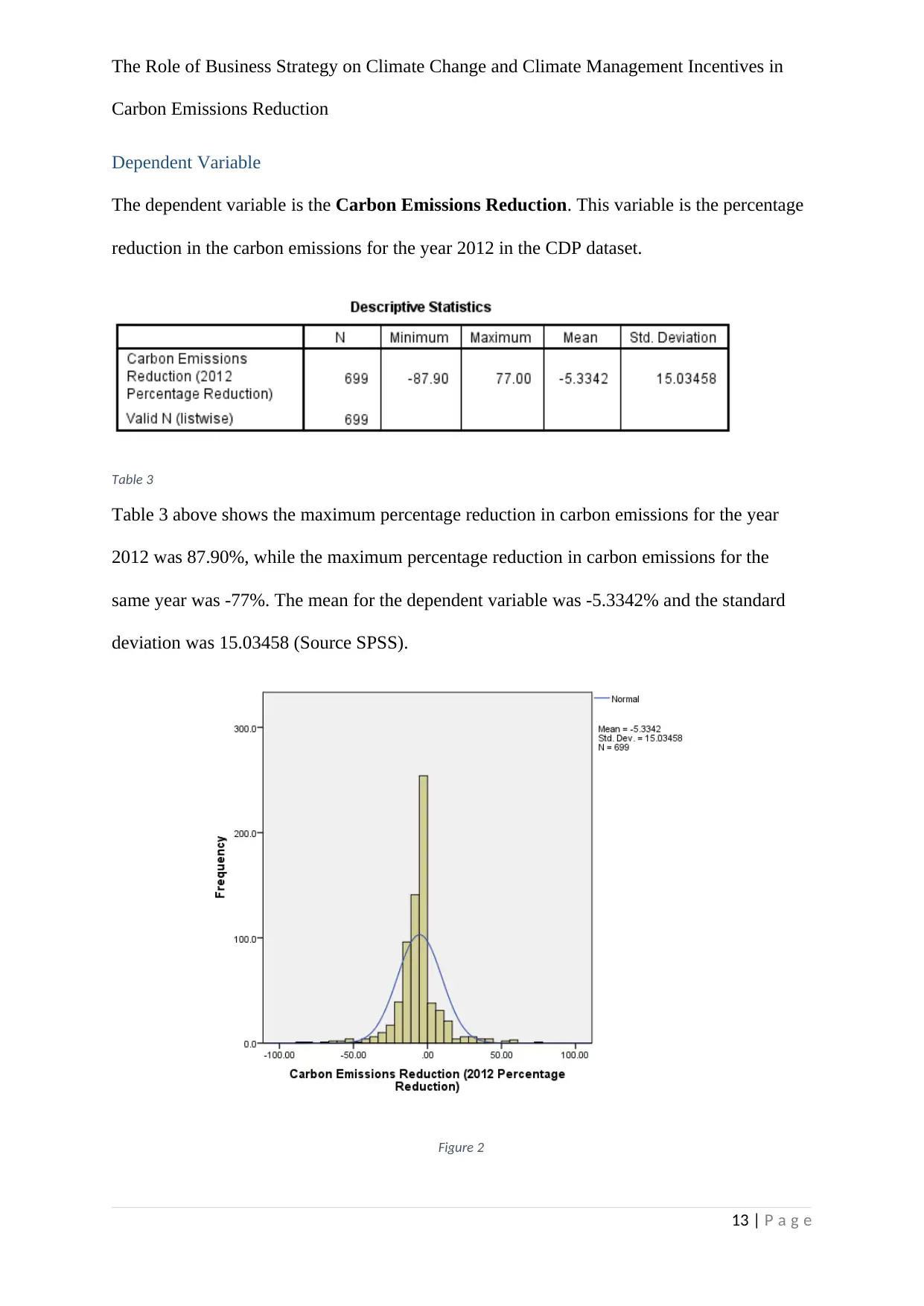
The Role of Business Strategy on Climate Change and Climate Management Incentives in
Carbon Emissions Reduction
Dependent Variable
The dependent variable is the Carbon Emissions Reduction. This variable is the percentage
reduction in the carbon emissions for the year 2012 in the CDP dataset.
Table 3
Table 3 above shows the maximum percentage reduction in carbon emissions for the year
2012 was 87.90%, while the maximum percentage reduction in carbon emissions for the
same year was -77%. The mean for the dependent variable was -5.3342% and the standard
deviation was 15.03458 (Source SPSS).
Figure 2
13 | P a g e
Carbon Emissions Reduction
Dependent Variable
The dependent variable is the Carbon Emissions Reduction. This variable is the percentage
reduction in the carbon emissions for the year 2012 in the CDP dataset.
Table 3
Table 3 above shows the maximum percentage reduction in carbon emissions for the year
2012 was 87.90%, while the maximum percentage reduction in carbon emissions for the
same year was -77%. The mean for the dependent variable was -5.3342% and the standard
deviation was 15.03458 (Source SPSS).
Figure 2
13 | P a g e
Paraphrase This Document
Need a fresh take? Get an instant paraphrase of this document with our AI Paraphraser
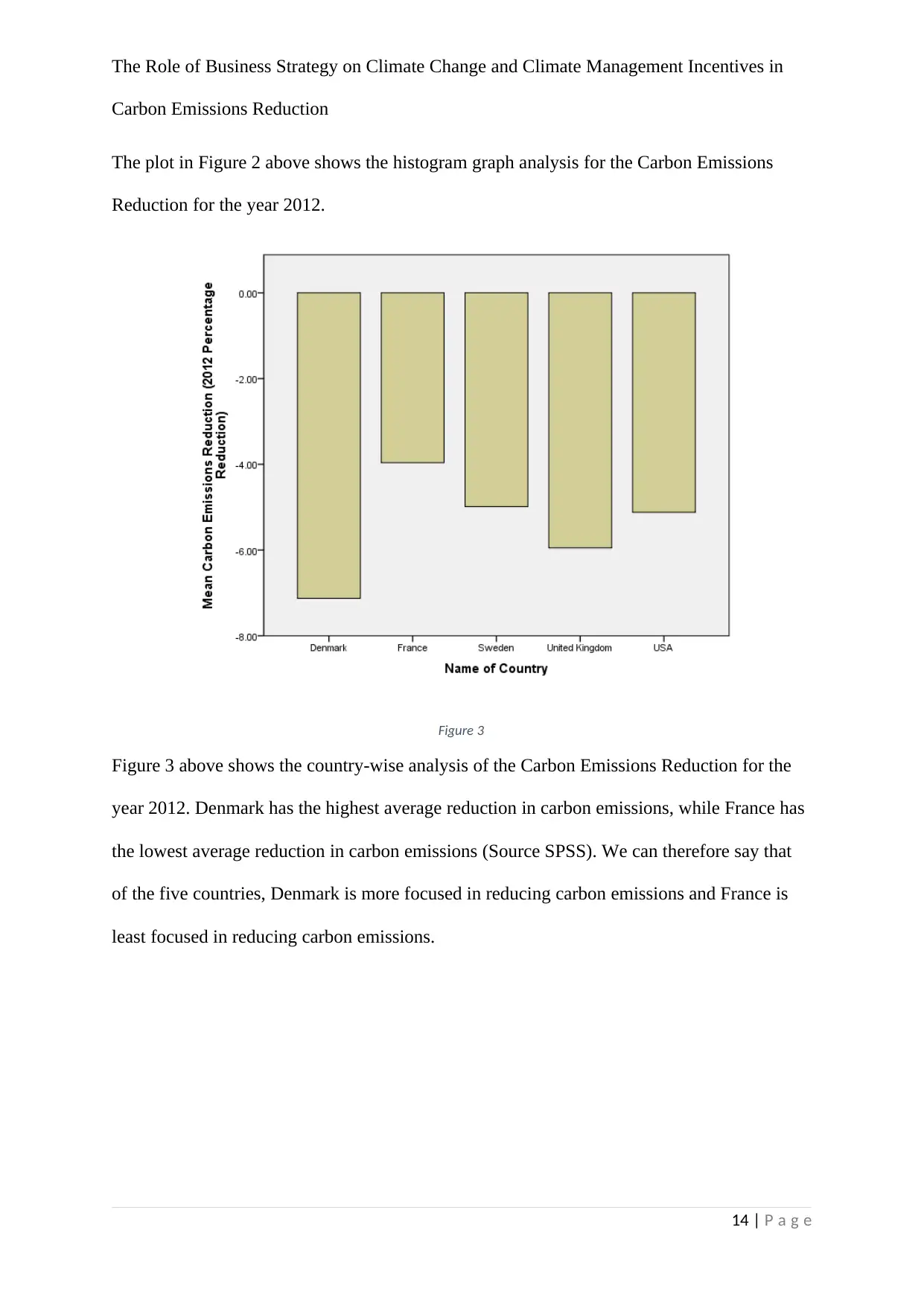
The Role of Business Strategy on Climate Change and Climate Management Incentives in
Carbon Emissions Reduction
The plot in Figure 2 above shows the histogram graph analysis for the Carbon Emissions
Reduction for the year 2012.
Figure 3
Figure 3 above shows the country-wise analysis of the Carbon Emissions Reduction for the
year 2012. Denmark has the highest average reduction in carbon emissions, while France has
the lowest average reduction in carbon emissions (Source SPSS). We can therefore say that
of the five countries, Denmark is more focused in reducing carbon emissions and France is
least focused in reducing carbon emissions.
14 | P a g e
Carbon Emissions Reduction
The plot in Figure 2 above shows the histogram graph analysis for the Carbon Emissions
Reduction for the year 2012.
Figure 3
Figure 3 above shows the country-wise analysis of the Carbon Emissions Reduction for the
year 2012. Denmark has the highest average reduction in carbon emissions, while France has
the lowest average reduction in carbon emissions (Source SPSS). We can therefore say that
of the five countries, Denmark is more focused in reducing carbon emissions and France is
least focused in reducing carbon emissions.
14 | P a g e
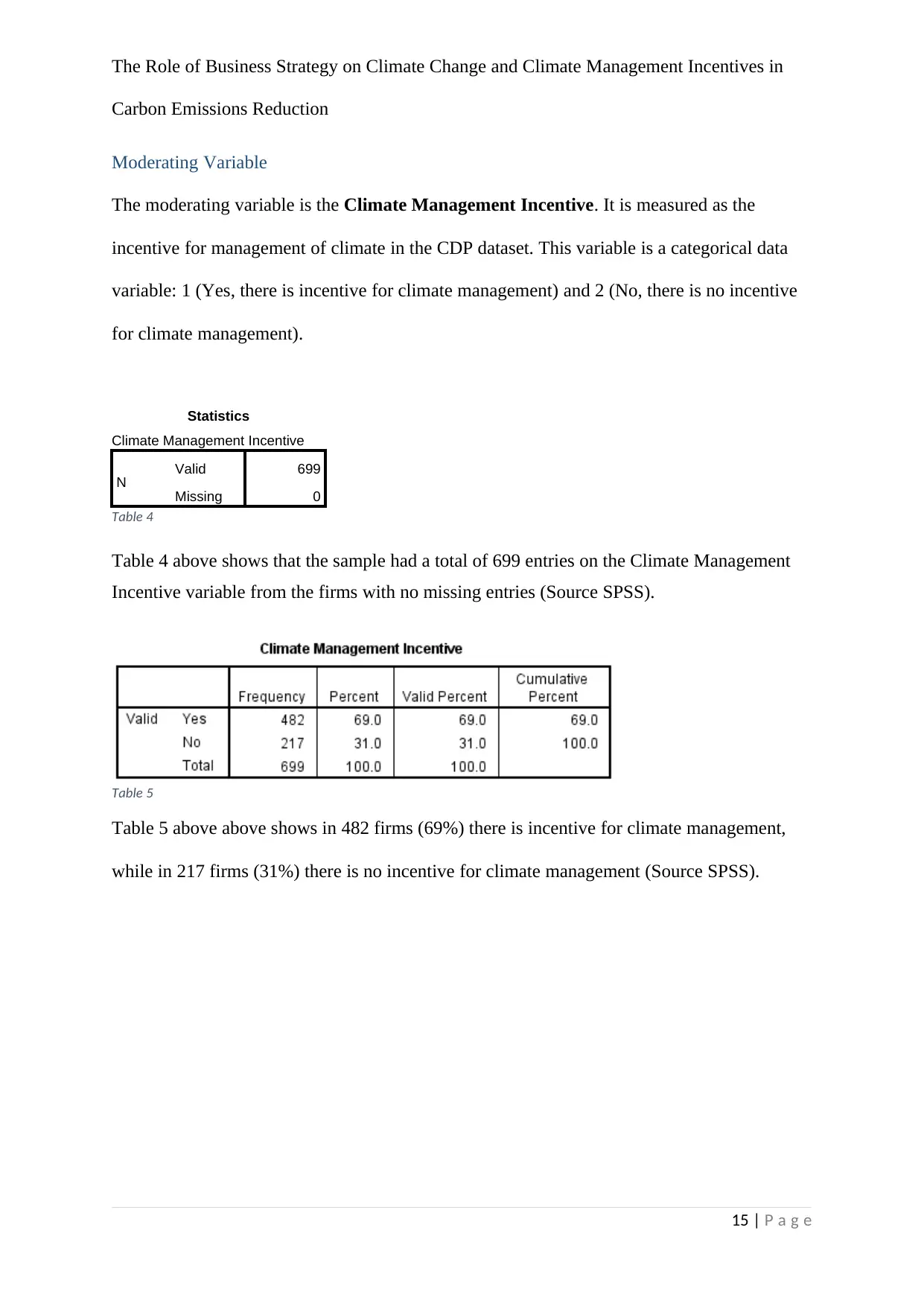
The Role of Business Strategy on Climate Change and Climate Management Incentives in
Carbon Emissions Reduction
Moderating Variable
The moderating variable is the Climate Management Incentive. It is measured as the
incentive for management of climate in the CDP dataset. This variable is a categorical data
variable: 1 (Yes, there is incentive for climate management) and 2 (No, there is no incentive
for climate management).
Statistics
Climate Management Incentive
N Valid 699
Missing 0
Table 4
Table 4 above shows that the sample had a total of 699 entries on the Climate Management
Incentive variable from the firms with no missing entries (Source SPSS).
Table 5
Table 5 above above shows in 482 firms (69%) there is incentive for climate management,
while in 217 firms (31%) there is no incentive for climate management (Source SPSS).
15 | P a g e
Carbon Emissions Reduction
Moderating Variable
The moderating variable is the Climate Management Incentive. It is measured as the
incentive for management of climate in the CDP dataset. This variable is a categorical data
variable: 1 (Yes, there is incentive for climate management) and 2 (No, there is no incentive
for climate management).
Statistics
Climate Management Incentive
N Valid 699
Missing 0
Table 4
Table 4 above shows that the sample had a total of 699 entries on the Climate Management
Incentive variable from the firms with no missing entries (Source SPSS).
Table 5
Table 5 above above shows in 482 firms (69%) there is incentive for climate management,
while in 217 firms (31%) there is no incentive for climate management (Source SPSS).
15 | P a g e
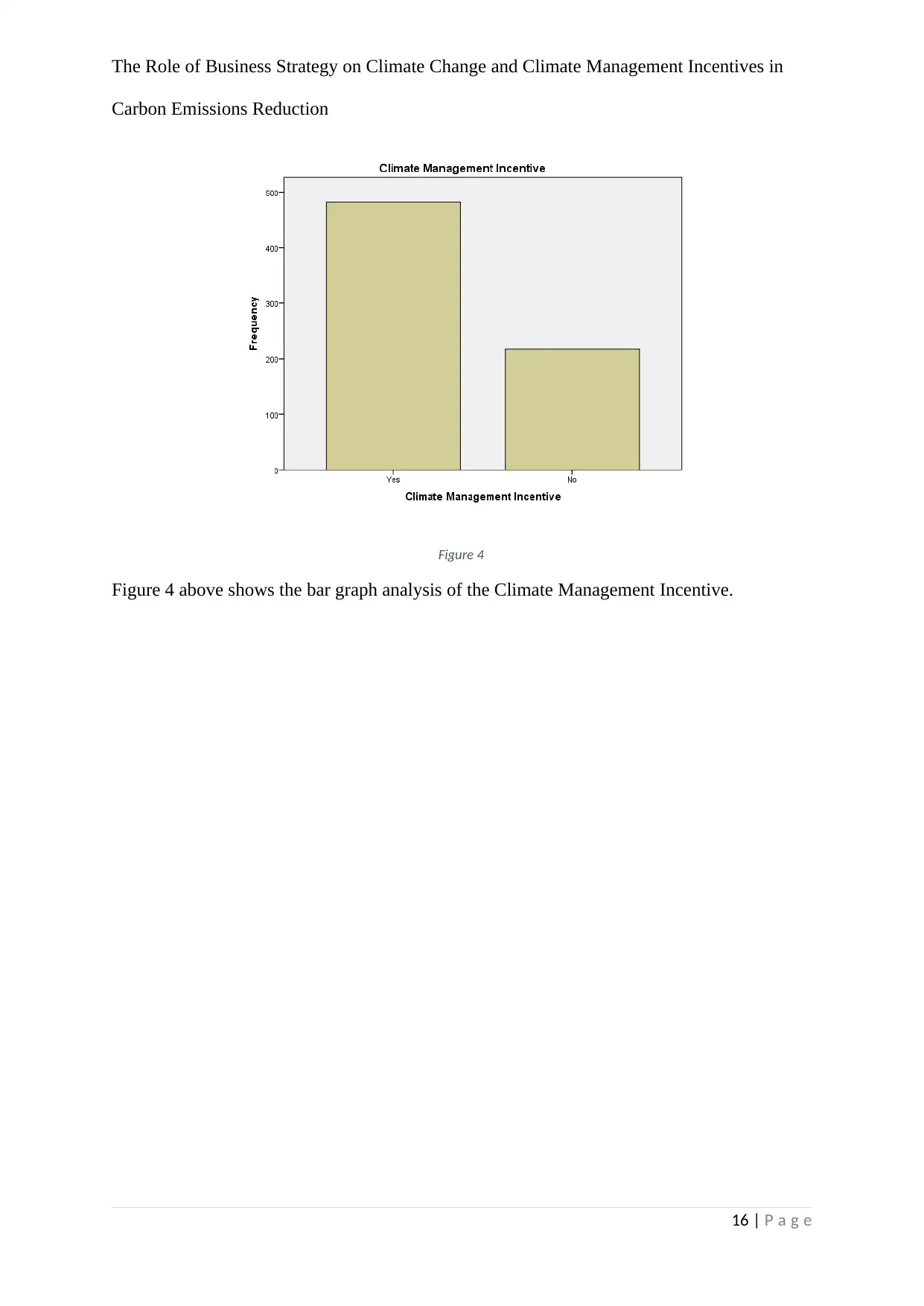
The Role of Business Strategy on Climate Change and Climate Management Incentives in
Carbon Emissions Reduction
Figure 4
Figure 4 above shows the bar graph analysis of the Climate Management Incentive.
16 | P a g e
Carbon Emissions Reduction
Figure 4
Figure 4 above shows the bar graph analysis of the Climate Management Incentive.
16 | P a g e
Secure Best Marks with AI Grader
Need help grading? Try our AI Grader for instant feedback on your assignments.
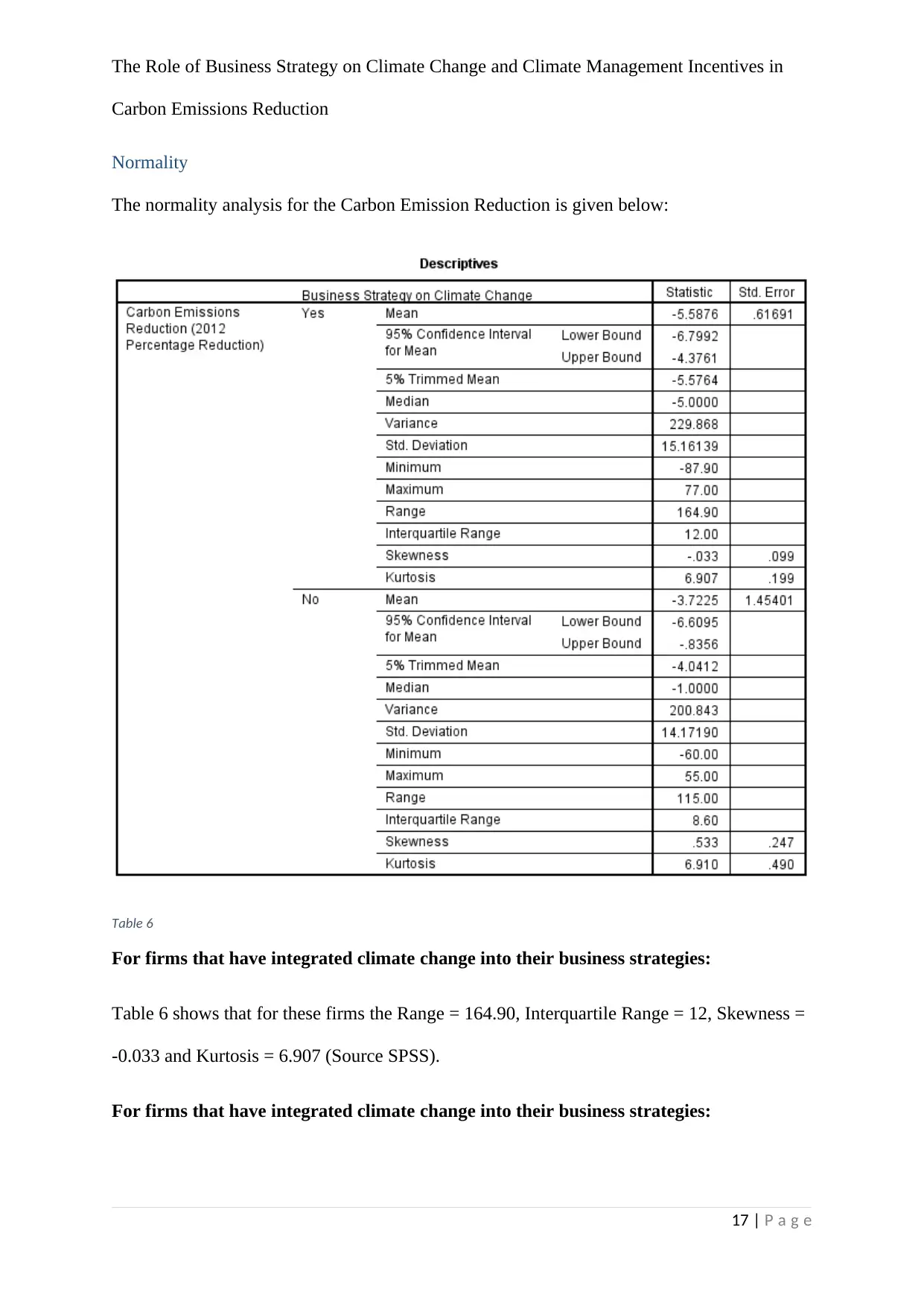
The Role of Business Strategy on Climate Change and Climate Management Incentives in
Carbon Emissions Reduction
Normality
The normality analysis for the Carbon Emission Reduction is given below:
Table 6
For firms that have integrated climate change into their business strategies:
Table 6 shows that for these firms the Range = 164.90, Interquartile Range = 12, Skewness =
-0.033 and Kurtosis = 6.907 (Source SPSS).
For firms that have integrated climate change into their business strategies:
17 | P a g e
Carbon Emissions Reduction
Normality
The normality analysis for the Carbon Emission Reduction is given below:
Table 6
For firms that have integrated climate change into their business strategies:
Table 6 shows that for these firms the Range = 164.90, Interquartile Range = 12, Skewness =
-0.033 and Kurtosis = 6.907 (Source SPSS).
For firms that have integrated climate change into their business strategies:
17 | P a g e
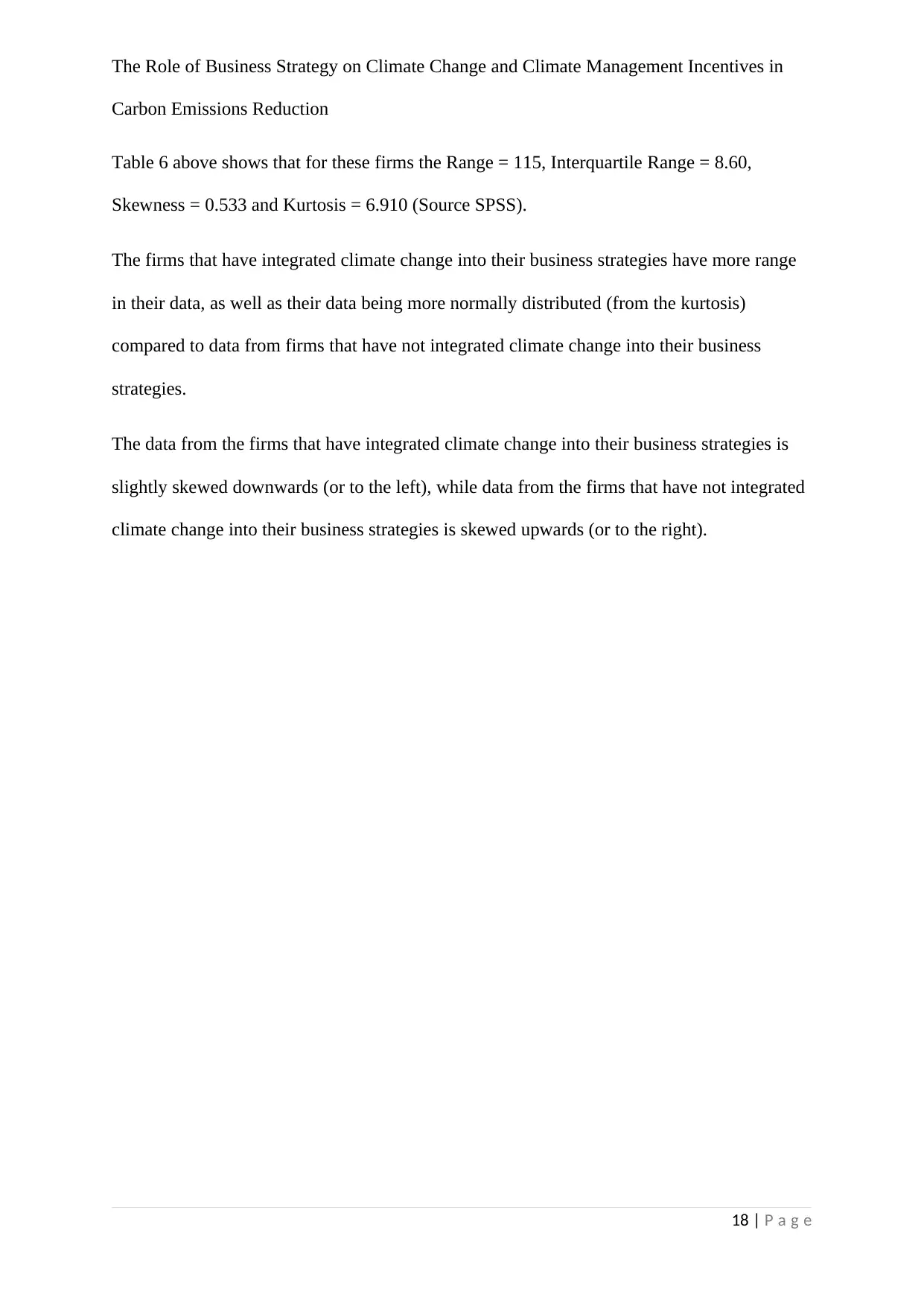
The Role of Business Strategy on Climate Change and Climate Management Incentives in
Carbon Emissions Reduction
Table 6 above shows that for these firms the Range = 115, Interquartile Range = 8.60,
Skewness = 0.533 and Kurtosis = 6.910 (Source SPSS).
The firms that have integrated climate change into their business strategies have more range
in their data, as well as their data being more normally distributed (from the kurtosis)
compared to data from firms that have not integrated climate change into their business
strategies.
The data from the firms that have integrated climate change into their business strategies is
slightly skewed downwards (or to the left), while data from the firms that have not integrated
climate change into their business strategies is skewed upwards (or to the right).
18 | P a g e
Carbon Emissions Reduction
Table 6 above shows that for these firms the Range = 115, Interquartile Range = 8.60,
Skewness = 0.533 and Kurtosis = 6.910 (Source SPSS).
The firms that have integrated climate change into their business strategies have more range
in their data, as well as their data being more normally distributed (from the kurtosis)
compared to data from firms that have not integrated climate change into their business
strategies.
The data from the firms that have integrated climate change into their business strategies is
slightly skewed downwards (or to the left), while data from the firms that have not integrated
climate change into their business strategies is skewed upwards (or to the right).
18 | P a g e
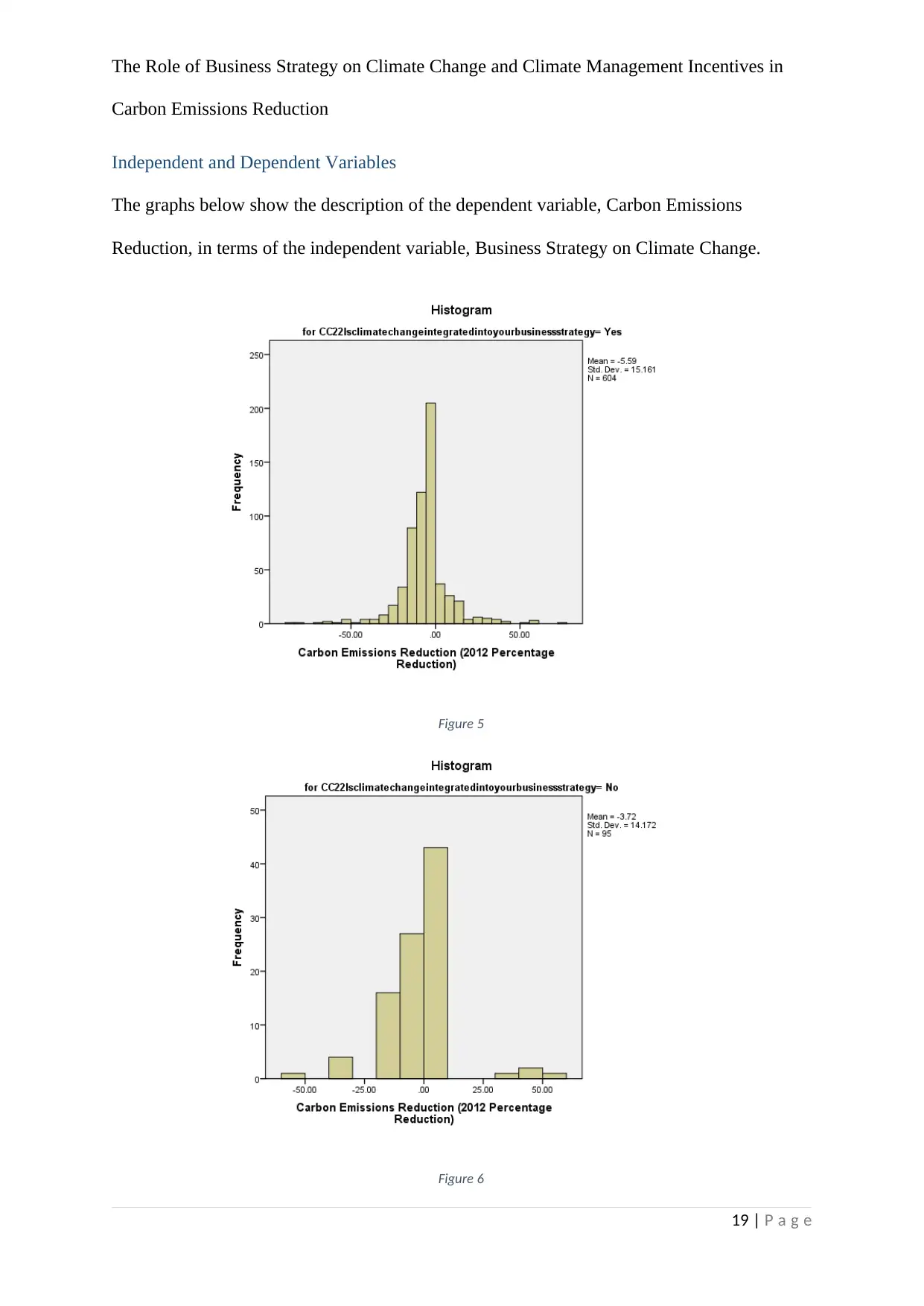
The Role of Business Strategy on Climate Change and Climate Management Incentives in
Carbon Emissions Reduction
Independent and Dependent Variables
The graphs below show the description of the dependent variable, Carbon Emissions
Reduction, in terms of the independent variable, Business Strategy on Climate Change.
Figure 5
Figure 6
19 | P a g e
Carbon Emissions Reduction
Independent and Dependent Variables
The graphs below show the description of the dependent variable, Carbon Emissions
Reduction, in terms of the independent variable, Business Strategy on Climate Change.
Figure 5
Figure 6
19 | P a g e
Paraphrase This Document
Need a fresh take? Get an instant paraphrase of this document with our AI Paraphraser
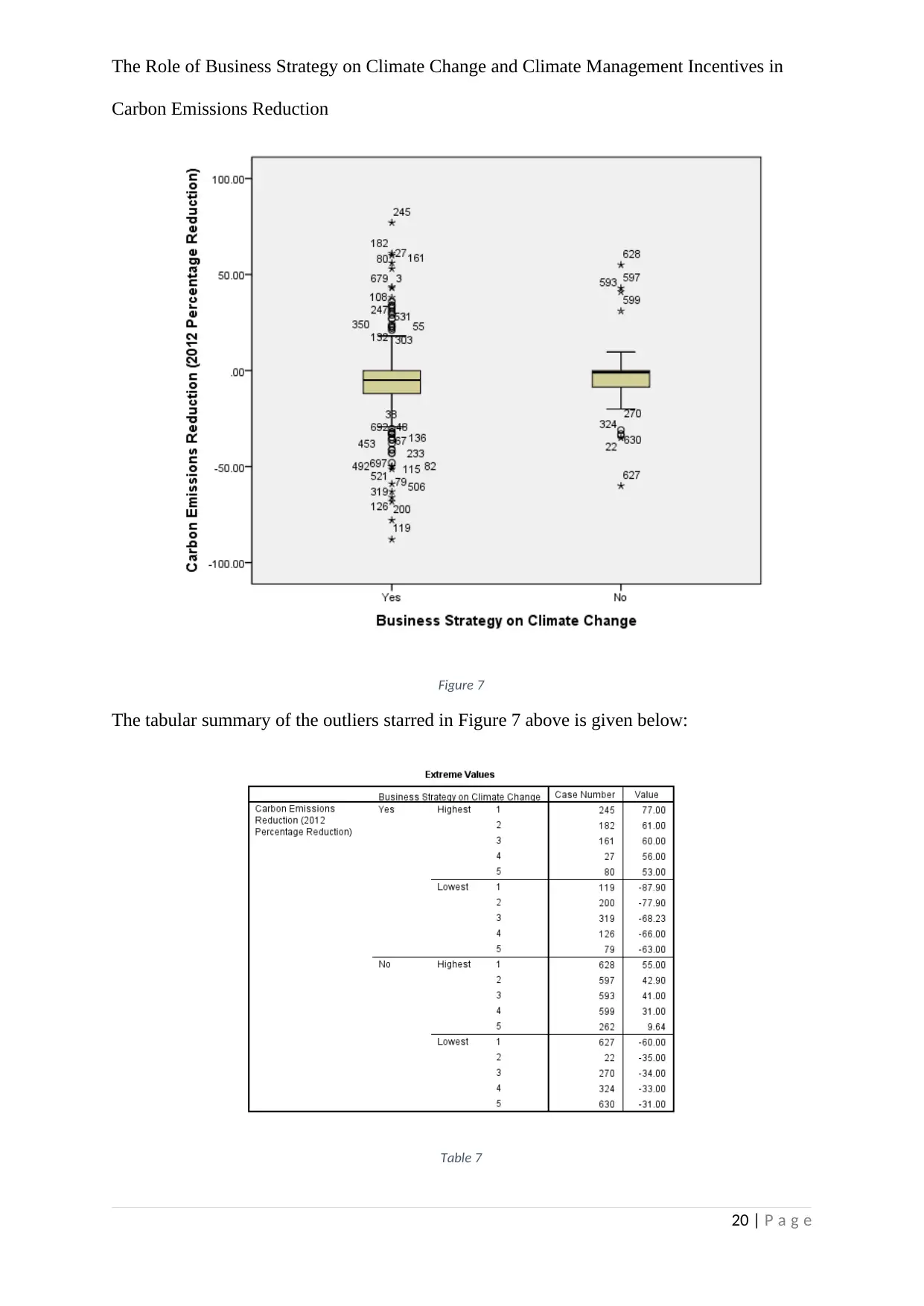
The Role of Business Strategy on Climate Change and Climate Management Incentives in
Carbon Emissions Reduction
Figure 7
The tabular summary of the outliers starred in Figure 7 above is given below:
Table 7
20 | P a g e
Carbon Emissions Reduction
Figure 7
The tabular summary of the outliers starred in Figure 7 above is given below:
Table 7
20 | P a g e
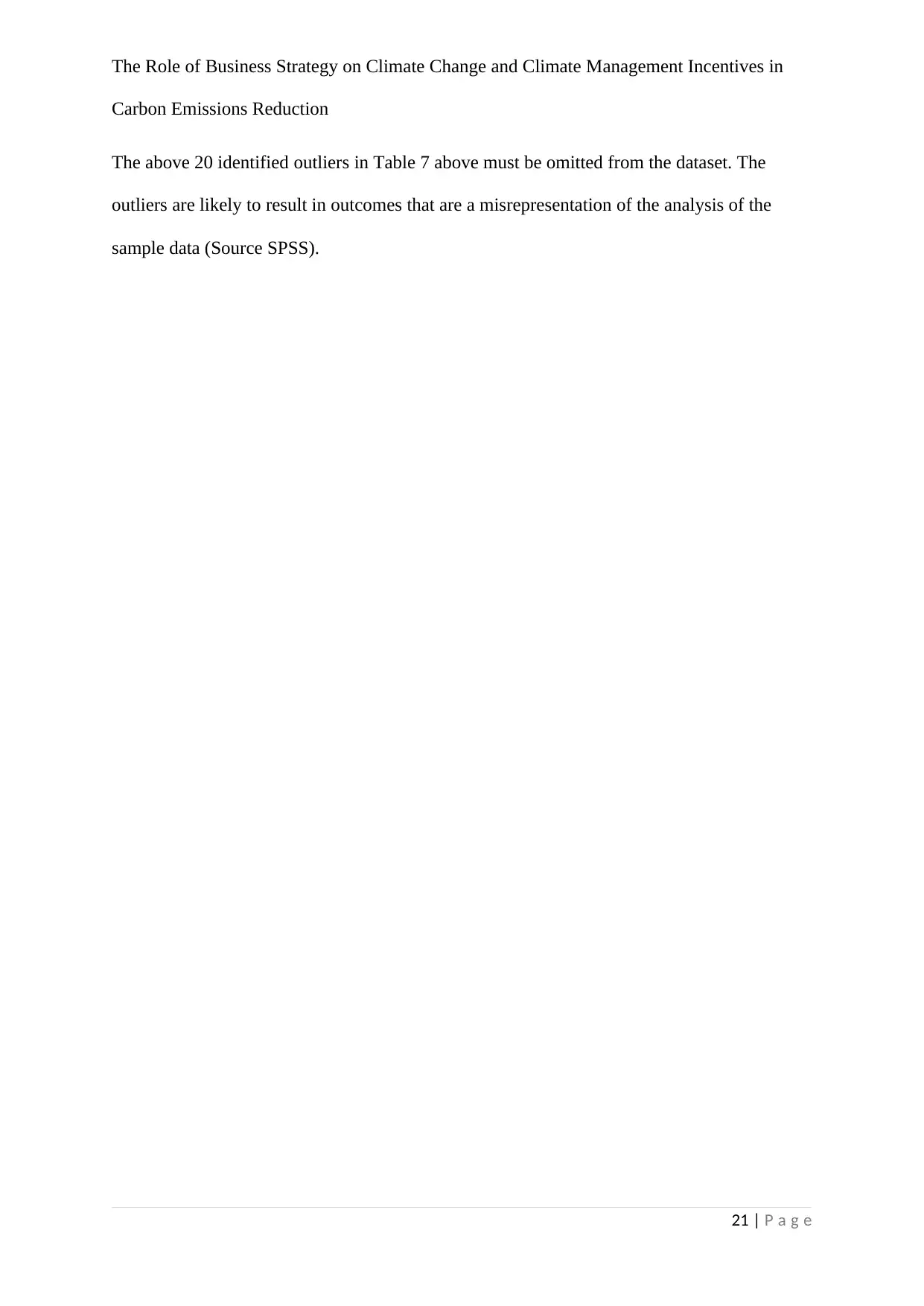
The Role of Business Strategy on Climate Change and Climate Management Incentives in
Carbon Emissions Reduction
The above 20 identified outliers in Table 7 above must be omitted from the dataset. The
outliers are likely to result in outcomes that are a misrepresentation of the analysis of the
sample data (Source SPSS).
21 | P a g e
Carbon Emissions Reduction
The above 20 identified outliers in Table 7 above must be omitted from the dataset. The
outliers are likely to result in outcomes that are a misrepresentation of the analysis of the
sample data (Source SPSS).
21 | P a g e
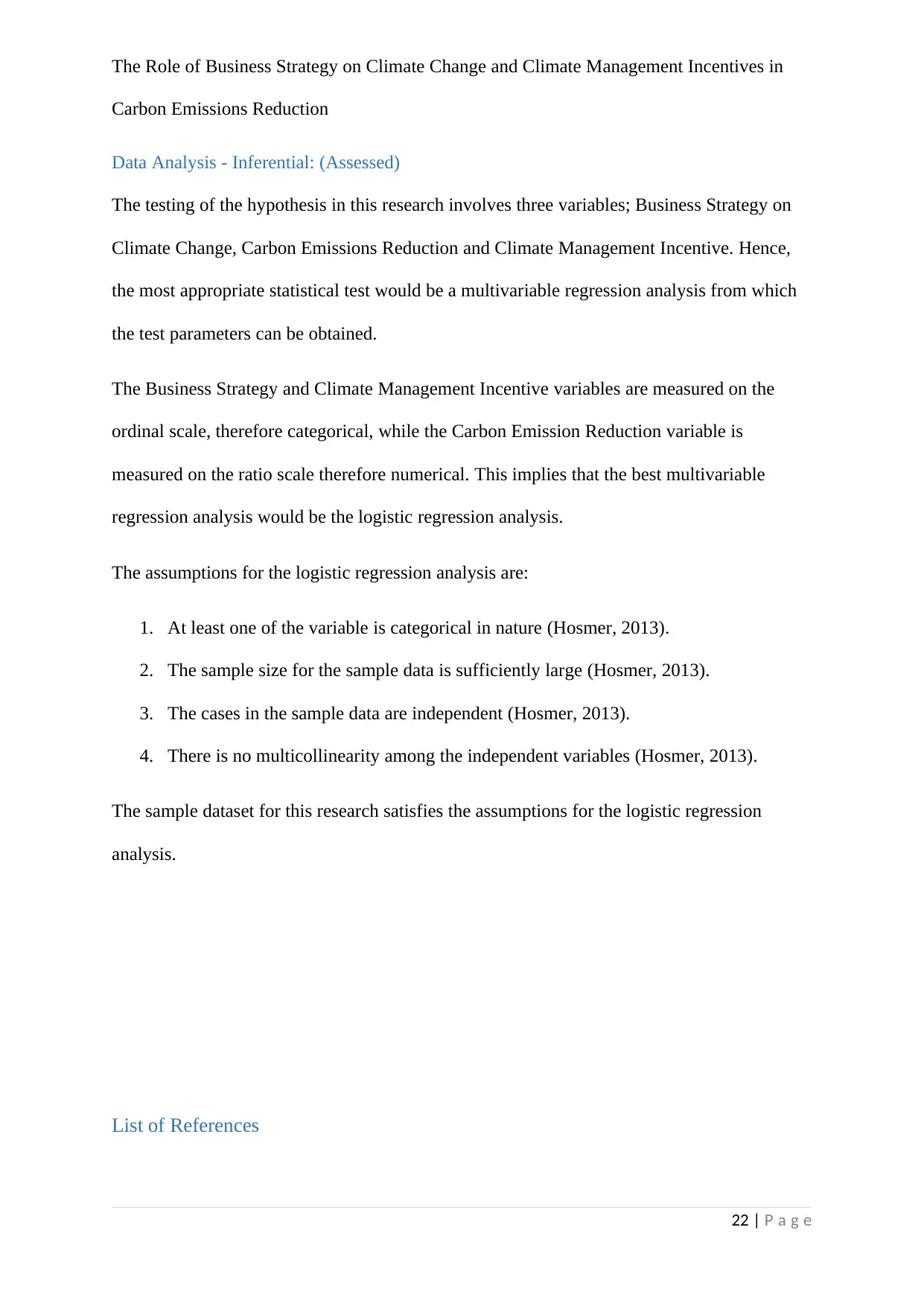
The Role of Business Strategy on Climate Change and Climate Management Incentives in
Carbon Emissions Reduction
Data Analysis - Inferential: (Assessed)
The testing of the hypothesis in this research involves three variables; Business Strategy on
Climate Change, Carbon Emissions Reduction and Climate Management Incentive. Hence,
the most appropriate statistical test would be a multivariable regression analysis from which
the test parameters can be obtained.
The Business Strategy and Climate Management Incentive variables are measured on the
ordinal scale, therefore categorical, while the Carbon Emission Reduction variable is
measured on the ratio scale therefore numerical. This implies that the best multivariable
regression analysis would be the logistic regression analysis.
The assumptions for the logistic regression analysis are:
1. At least one of the variable is categorical in nature (Hosmer, 2013).
2. The sample size for the sample data is sufficiently large (Hosmer, 2013).
3. The cases in the sample data are independent (Hosmer, 2013).
4. There is no multicollinearity among the independent variables (Hosmer, 2013).
The sample dataset for this research satisfies the assumptions for the logistic regression
analysis.
List of References
22 | P a g e
Carbon Emissions Reduction
Data Analysis - Inferential: (Assessed)
The testing of the hypothesis in this research involves three variables; Business Strategy on
Climate Change, Carbon Emissions Reduction and Climate Management Incentive. Hence,
the most appropriate statistical test would be a multivariable regression analysis from which
the test parameters can be obtained.
The Business Strategy and Climate Management Incentive variables are measured on the
ordinal scale, therefore categorical, while the Carbon Emission Reduction variable is
measured on the ratio scale therefore numerical. This implies that the best multivariable
regression analysis would be the logistic regression analysis.
The assumptions for the logistic regression analysis are:
1. At least one of the variable is categorical in nature (Hosmer, 2013).
2. The sample size for the sample data is sufficiently large (Hosmer, 2013).
3. The cases in the sample data are independent (Hosmer, 2013).
4. There is no multicollinearity among the independent variables (Hosmer, 2013).
The sample dataset for this research satisfies the assumptions for the logistic regression
analysis.
List of References
22 | P a g e
Secure Best Marks with AI Grader
Need help grading? Try our AI Grader for instant feedback on your assignments.
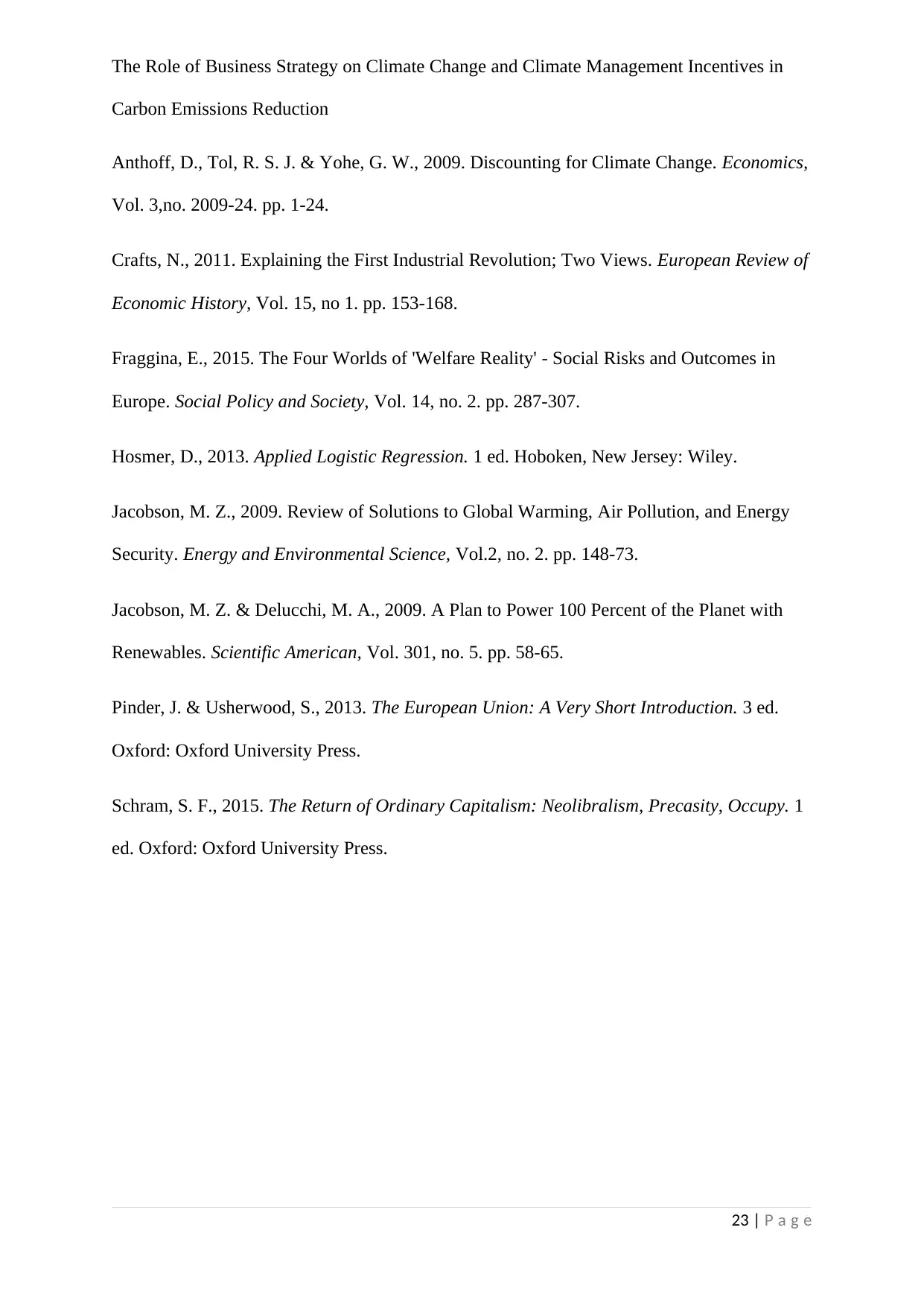
The Role of Business Strategy on Climate Change and Climate Management Incentives in
Carbon Emissions Reduction
Anthoff, D., Tol, R. S. J. & Yohe, G. W., 2009. Discounting for Climate Change. Economics,
Vol. 3,no. 2009-24. pp. 1-24.
Crafts, N., 2011. Explaining the First Industrial Revolution; Two Views. European Review of
Economic History, Vol. 15, no 1. pp. 153-168.
Fraggina, E., 2015. The Four Worlds of 'Welfare Reality' - Social Risks and Outcomes in
Europe. Social Policy and Society, Vol. 14, no. 2. pp. 287-307.
Hosmer, D., 2013. Applied Logistic Regression. 1 ed. Hoboken, New Jersey: Wiley.
Jacobson, M. Z., 2009. Review of Solutions to Global Warming, Air Pollution, and Energy
Security. Energy and Environmental Science, Vol.2, no. 2. pp. 148-73.
Jacobson, M. Z. & Delucchi, M. A., 2009. A Plan to Power 100 Percent of the Planet with
Renewables. Scientific American, Vol. 301, no. 5. pp. 58-65.
Pinder, J. & Usherwood, S., 2013. The European Union: A Very Short Introduction. 3 ed.
Oxford: Oxford University Press.
Schram, S. F., 2015. The Return of Ordinary Capitalism: Neolibralism, Precasity, Occupy. 1
ed. Oxford: Oxford University Press.
23 | P a g e
Carbon Emissions Reduction
Anthoff, D., Tol, R. S. J. & Yohe, G. W., 2009. Discounting for Climate Change. Economics,
Vol. 3,no. 2009-24. pp. 1-24.
Crafts, N., 2011. Explaining the First Industrial Revolution; Two Views. European Review of
Economic History, Vol. 15, no 1. pp. 153-168.
Fraggina, E., 2015. The Four Worlds of 'Welfare Reality' - Social Risks and Outcomes in
Europe. Social Policy and Society, Vol. 14, no. 2. pp. 287-307.
Hosmer, D., 2013. Applied Logistic Regression. 1 ed. Hoboken, New Jersey: Wiley.
Jacobson, M. Z., 2009. Review of Solutions to Global Warming, Air Pollution, and Energy
Security. Energy and Environmental Science, Vol.2, no. 2. pp. 148-73.
Jacobson, M. Z. & Delucchi, M. A., 2009. A Plan to Power 100 Percent of the Planet with
Renewables. Scientific American, Vol. 301, no. 5. pp. 58-65.
Pinder, J. & Usherwood, S., 2013. The European Union: A Very Short Introduction. 3 ed.
Oxford: Oxford University Press.
Schram, S. F., 2015. The Return of Ordinary Capitalism: Neolibralism, Precasity, Occupy. 1
ed. Oxford: Oxford University Press.
23 | P a g e
1 out of 23
Your All-in-One AI-Powered Toolkit for Academic Success.
+13062052269
info@desklib.com
Available 24*7 on WhatsApp / Email
![[object Object]](/_next/static/media/star-bottom.7253800d.svg)
Unlock your academic potential
© 2024 | Zucol Services PVT LTD | All rights reserved.



